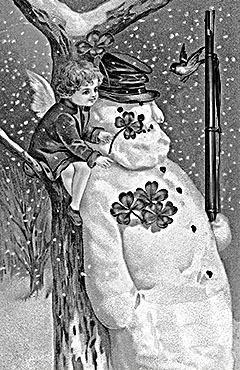
Please send all Checks and Money orders to :
Dave Taylor P.O. Box 87 Sylvania, OH 43560
419-842-1863
Click Here to E-mail Us!
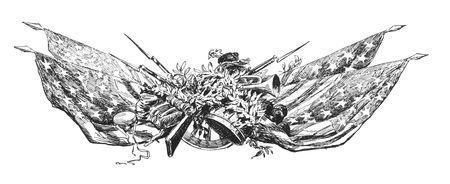

14 01


14-01-01 … CONFEDERATE FAYETTEVILLE RIFLE – 1863 – TYPE IV:
A totally original and genuine Confederate Fayetteville rifle that is affordable. This is totally original and complete except for the rear sight which is a Springfield example, and the ramrod which is a variant. I purchased this last month from an ages old Michigan collection, from the 65 year old son of the deceased collector. It is a mid-war 1863 Confederate Fayetteville Rifle. These Fayettevilles were based on the US-Harpers Ferry 1855 pattern rifle. In 1861 the Confederates under Stonewall Jackson captured the Harpers Ferry arsenal and confiscated the machinery and gun parts used for making this model. The first guns were assembled out of US parts and a smattering of CS parts. Then Richmond Arsenal became involved and produced the locks during 1862. By 1863 the production became more regular in North Carolina where the guns were made with nearly exclusively CS made parts. The rifle here offered is a solid mid war gun of total Confederate manufactured parts except for the rear sight. It has the standard low-hump lock with date of 1863 behind the hammer, image of an eagle above “CSA” and “FAYETTEVILLE” forward of the hammer. The breech of the barrel has the “V P” and image of eagle’s head clearly visible. The 1863 barrel date is visible mixed with some pitting. The stock is a standard CS Fayetteville stock with the brass nose cap, brass CSA marked butt plate, and standard flat brass bands. The stock has good edges and a repaired crack at the wrist (very well done). Bore is smooth bored to roughly 69 caliber which we see on about 35% of these rifles. The brass bands are marked “U” on each to indicate which edge is the “up” edge. The ramrod appears to be Confederate but not a standard Fayetteville style. This desirable CSA rifle is overall very good condition and totally complete. If you are looking for a dead-real Confederate rifle but don’t want to spend the price of a new car, this Fayetteville is just the ticket. In this totally odd and unpredictable economy, I believe putting our money in antiques, art, and guns may be the smart move. This one is a truly fair and honest buy at
… $6,900.00 SOLD
Click Here to E-mail Us!
Call us @ 419-842-1863

14-01-02 … Civil War Austrian Lorenz 1854 pattern rifle …
These .54 caliber rifles were imported by both sides in the Civil War in huge numbers. They were well liked, accurate, slightly shorter than the Springfields and Enfields, and mounted their own pattern of socket bayonet: a quadrangular blade with a socket cut with a spiral slot. This is a nice example with typical European light colored wood, good metal, and a smattering of European markings. Barrel shows faded blue mixed with brown. Very smooth barrel with no firing corrosion at the breech or on the bolster. The lockplate, hammer and other hardened parts show a dull silver with scattered brown spots. Karl Heiser maker’s stamp is on the barrel top at breech. Small bench numbers elsewhere and what seems to be a unit mark on the left flat at breech. Folding ladder rear sight intact, and made w/ no cheekrest on left butt. Front sight in place on correct oval base. A little roughness on the butt plate from resting on the floor and a bit of wear to the wood edge next to it. No big deal. Good edges to the wood around the lock and on reverse. Clear “861” lockplate mark indicating 1861 manufacture, so this gun was pretty new when it made its way over here. Rod, swivels, bands, springs, etc., all original. A very desirable Civil War rifle imported in numbers second only to the Enfield and used by both sides. If you are building an arms collection or illustrating weapons used by either side this would be an ideal addition to the gunroom wall. Overall VG with fine .54 caliber rifled bore
… $1,350.00
(Bayonet available for $165.)
SOLD
Click Here to E-mail Us!
Call us @ 419-842-1863

14-01-03 … Indian War Infantry Coat:
A family near here sent this and sold it to me. I have to confess that I do not know exactly what it is. Officer’s? Musician’s? Militia? It is pretty much an 1884 pattern infantry tunic but at one time had braid and galloons, and the cuffs are blue trim not white. It is a double-breasted blue wool coat with two rows of seven buttons. It once had quatrefoil galloons decorating the sleeves. Also had braid on the breast as can be told from the slight fading. White collar and vent trim on the reverse show clearly it was issued to an infantry unit. The name “Frost” appears once inside the back of the coat and again near an Albany, NY, clothier’s mark. The buttons on it are US general service eagle buttons. The name Schreiber is stamped in the coat above the Albany address, but I don’t find him as a maker and he might be a soldier. White upper body lining, brownish lower lining in the skirts. Very typical of early to mid 1880s. A couple of small holes in the white lining, a tear in the lining of the lower left skirt that can be easily mended. Solid overall, a nice starting point for an early uniform collection, and not bad condition at all for a uniform heading toward 140 years old.
… $225.00 SOLD
Click Here to E-mail Us!
Call us @ 419-842-1863

14-01-04 … US Army Indian War 1874 Pattern Mess Cup:
Regulation Custer Era army tinned iron cup. These are often sold to the unwary as Civil War, but were adopted in 1874 for use by the frontier army. Patterned after the late Civil War versions that used rivets for the handle instead of a combination of rivet and wire over the top edge, these kept the same dimensions of roughly 4 by 4 inches but incorporated an impressed “US” on the handle. Made of heavy duty tinned iron suitable for heating liquids over a camp fire if necessary, these were part of every soldier’s essential equipment in the field. Ours has lots of the original gray colored tinning left on the inside and out. The inside bottom is rusty, as is usually the case from moisture settling, but has no holes and is solid, and the handle shows mostly brown iron where the tin has worn off from use. A key piece of army gear, whatever branch of service, useful for boiling coffee and scooping out a shallow entrenchment when hostile fire got too hot. Not as easy to come by as they used to be.
… $69.00 SOLD
Click Here to E-mail Us!
Call us @ 419-842-1863
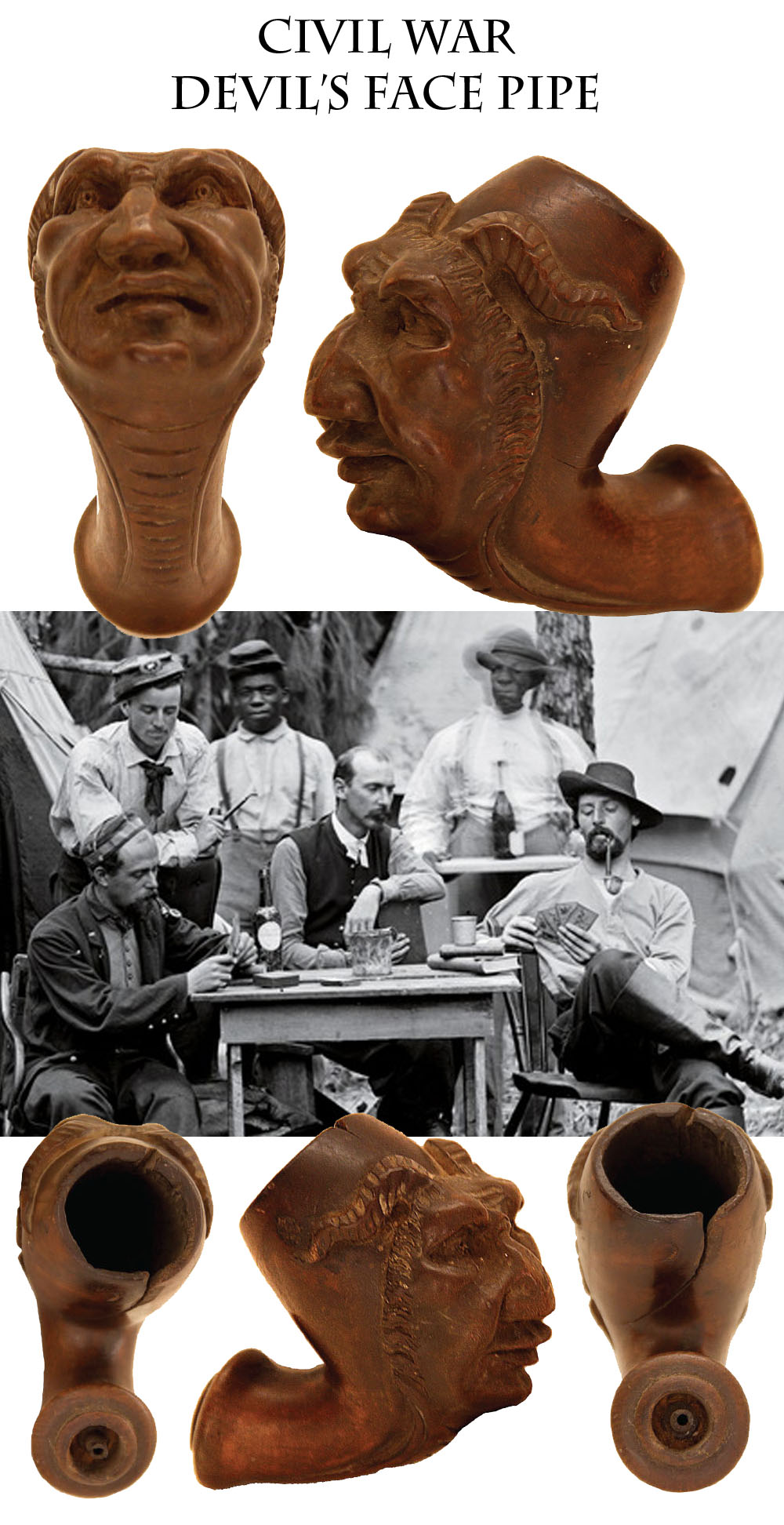
14-01-05 … Superb Carved Devil’s Face Pipe:
One of my personal favorites. This must have looked “wicked” when smoking and glowing! ;A really neat piece of folk art and “Tobacciana” as a friend of mine calls it. Pipe smoking was a favorite pastime in the army during the Civil War as well as on the frontier. And this is one heck of an 1860s large size carved pipe bowl. I can’t pass up neat smoking pipes and neither could our late good friend Norm Flayderman whose book on carved pipes is being completed by his family. This is one Norm would have appreciated. Not a pipe for use in the presence of ladies, this, a vividly carved face… part human, part beast, with protruding brows, wisps of shaggy hair and prominent ram’s horns. This must have looked pretty darn impressive when loaded up and lit. Small nick and crack on the top front edge, ;a larger one curling down on the reverse, but solid. This is a topnotch example and would look great in a “devilish” officer’s effects.
… $475.00
Click Here to E-mail Us!
Call us @ 419-842-1863
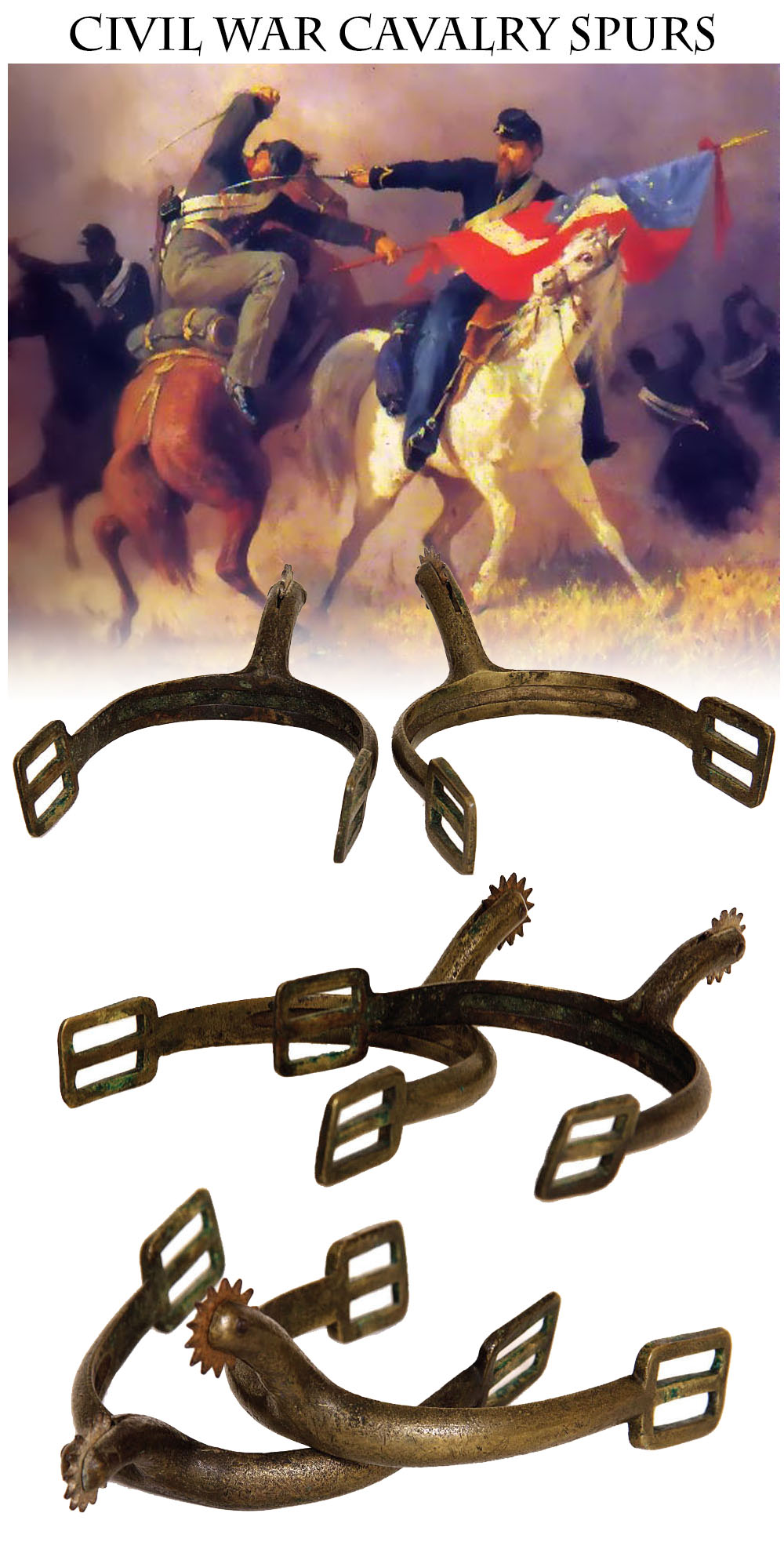
14-01-06 … Regulation Cavalry Spurs:
An extra fine pair of “dead-on-the-money” regulation Civil War Union Army cavalry spurs. I used to find these things everywhere. Now it is a darn rare occurrence
… $235.00
SOLD
Click Here to E-mail Us!
Call us @ 419-842-1863

14-01-07 … Classic Civil War Tower Enfield Rifle Musket, Maker Signed:
The quintessential Enfield as used by both Union and Confederate infantrymen, this one made by Robert Hughes. This one is NRA “very good+” condition. 100% original, 100% complete, mechanically perfect, and very handsome. Lock is clearly marked “1862 TOWER” and bears the CROWN stamp. The barrel bears the proper 25*25* stamping showing the gun is .577 caliber and as such there are 25 bullets to the pound. This 25*25* mark and the lesser seen 24*24* stamp are the proper ones for Enfields sent over for use during our Civil War. (24*24* indicates .58 caliber.) Also present on this fine musket is the original US issue rifle sling. Numerous British stock markings present as shown, by Robert Hughes of Birmingham. RH & crown twice and full oval cartouche on right side of butt stock. Also marked on barrel “RH”. . Small crack near lock screw. Owner’s name “JOHN KORWIN” is scratched into the butt stock. I cannot find an infantryman with that name in the rosters, but do find a late war cavalryman from New York. You can research further. A top notch example that you can be proud to display
… $1,750.00
Click Here to E-mail Us!
Call us @ 419-842-1863
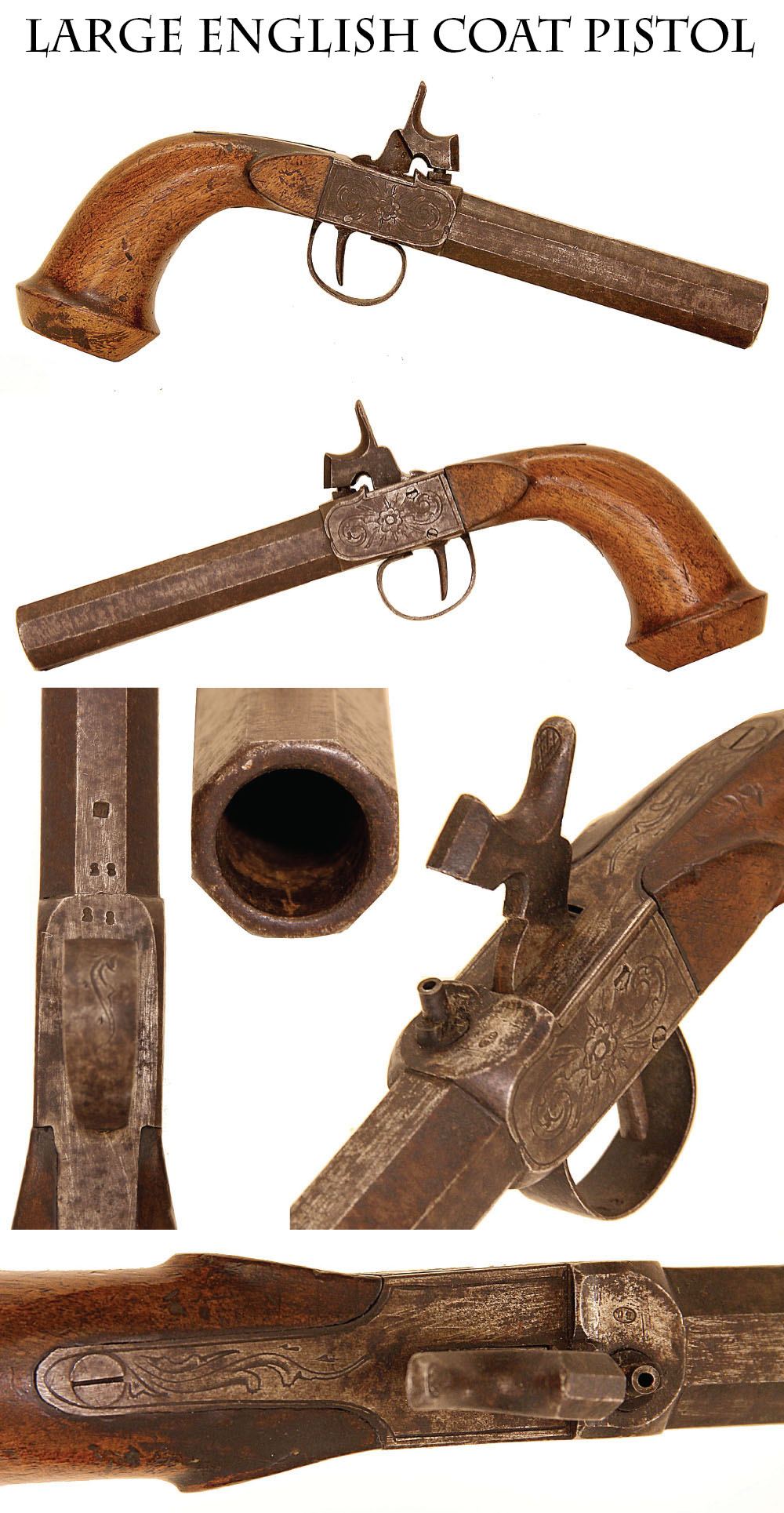
14-01-08 … Gentleman’s Percussion Coat Pistol:
Large bore, single shot percussion pistol with a hefty well-formed grip. These “man size” single-shot pistols with center-hung hammers were intended as discrete weapons of personal defense. As modes of transportation and travel changed, so too did weapon design. Long barrel horse pistols carried in saddle holsters gave way to shorter pistols carried in cases in carriages and lastly to these coat pocket weapons one might carry while out for a walk in a dangerous part of the city. Octagon, 4.5” barrel about .70 caliber, floral engraving on both sides of the receiver and bottom of the triggerguard. Bench number “28” on underside of barrel and frame, small cartouche near the number, and a maker’s mark “BC” in an oval near the nipple. Mixed brown and gray overall but with strong signs of the swirl bluing popular on many British guns. The grip with pronounced ring at base is French in style but made for a more secure grip on the gun. Nice wood, good nipple and mechanics. A lot of gun for the money
… $495.00 SOLD
Click Here to E-mail Us!
Call us @ 419-842-1863

14-01-09 … 1823 Dated R. Johnson Common Rifle in Original Flint.
These .52 Caliber Model 1817 U.S. Rifles are key pieces in a US martial arms collection. Called the “common rifle” to distinguish it from the Hall patterns being made at the same time, these guns are sharp looking with curving pistol grip triggerguard extensions, brass flash pans and oval iron patch boxes. Made only by contractors to the US government, not at the national arsenals (with the exception of the pattern guns), this example is by R. Johnson who had contracts in 1821-23 for 5,000 guns. Pre-Alamo, and pre-Seminole war. Ours is a very nice example, and especially desirable being in original flintlock configuration. There is an old repair to a crack in the wrist that could be improved upon. I simply don’t have the time to have the work done. The repair is old and solid, so it is simply a cosmetic choice as this is a darn nice gun the way it stands. The metal is generally smooth and “in the bright” with scattered dark spots overall but very sharp “US / P/ LS” barrel proofs on left side at breech and very legible lock marks: “R. Johnson/ U (eagle) S/ Middn Conn” forward of the hammer, and “1823” vertically to rear of hammer. Some salt-and-peppering to the breechplug tang, and buttplate tang. All bands, swivels, springs and rod in place. Even the screws show matching “66” bench numbers. Iron patchbox in place and functional. A small wood divot out at the latch top, but the cover latches fine. Two other scratches and two dimples in the wood just forward over the patchbox. Visible, though blurred, ink inspector’s cartouche present on the offside at wrist. Both sights in place, rifled bore is VG to fine. As American arms, military rifles are an interesting category unto themselves. This pattern is essential for a collection to show the development of rifles and also provides a number of variations and makers for the collector to acquire or study. The form itself is very pleasing. They were well liked as a gun. Most were later converted to percussion to be kept in service and even issued in the Civil War. This one in “original flint” is darn rare
… $2,450.00 SOLD
Click Here to E-mail Us!
Call us @ 419-842-1863
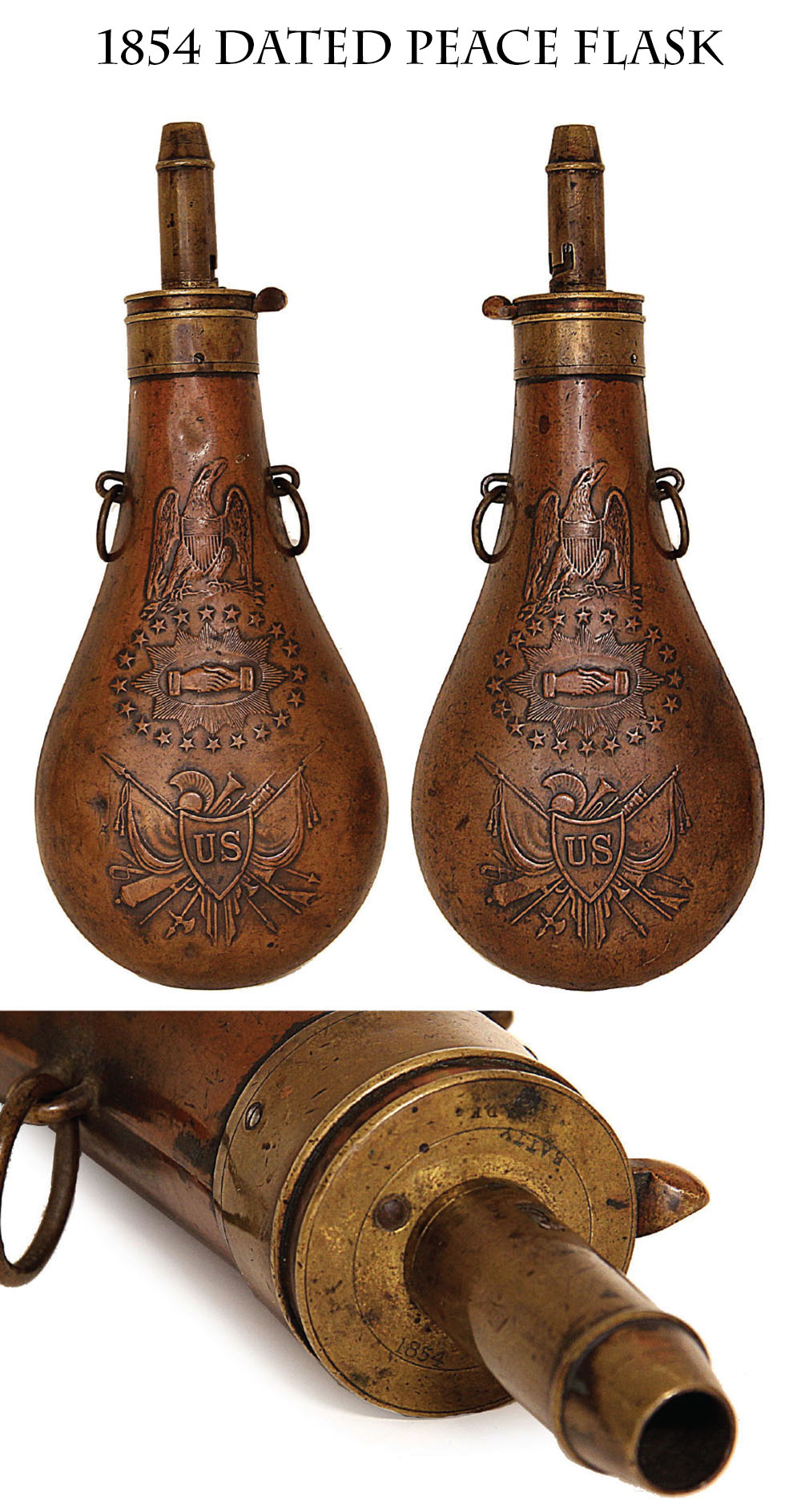
14-01-10 … Superb Regulation US Army Peace Flask / Powder Flask:
The most handsome powder flask produced for the US army. Carried with the equally handsome M1841 Mississippi rifles. This one made and signed by Batty and dated 1854. Complete, excellent, and mechanically perfect. Wonderful undisturbed age patina, and a wonderful fair price for such a top-end specimen
… $495.00 SOLD
Click Here to E-mail Us!
Call us @ 419-842-1863
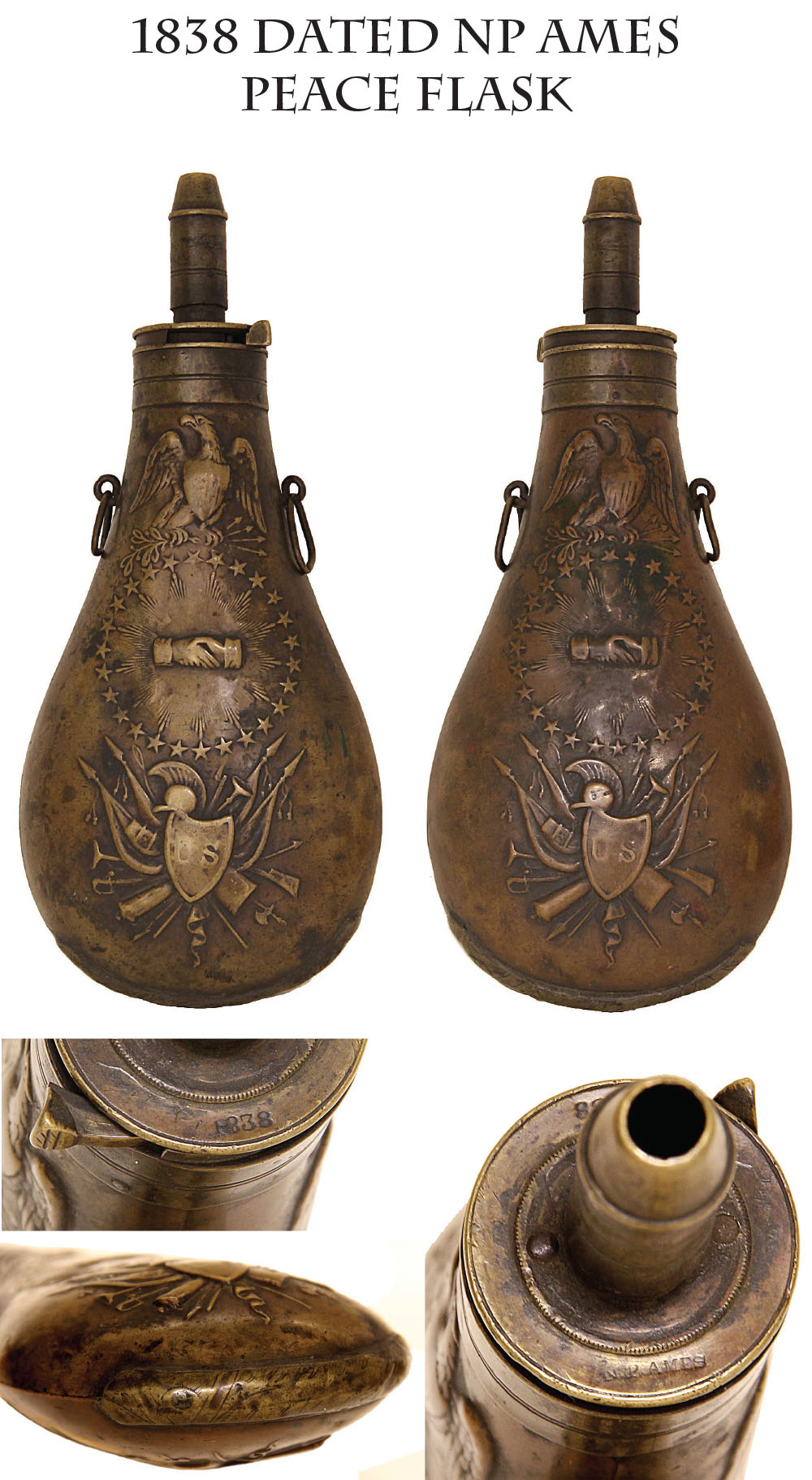
14-01-11 … Ames Early Pattern “M1838” Peace Flask w/ Eagle’s Head Facing to the Viewer’s Left:
This is the first pattern Peace Flask and was supplied to the US Army primarily for the purpose of arming state militias. Overall VG with a PERIOD reinforced repair along the bottom seam. Really appealing and adds great character. Spring for lever is either broken or missing. Otherwise fine. Nicely marked by Ames, dated 1838, and inspected. A handsome early flask
… $425.00 SOLD
Click Here to E-mail Us!
Call us @ 419-842-1863

14-01-12 … 1833 Dinge “Eagle” powder flask
…Scarce Model 1832 Riflemans Flask: Robert Dingee, the maker, was awarded a contract for 3,450 copper powder flasks on Feb. 20, 1832. This is an example from that contract. The contract required it to hold 9 ounces of rifle powder and be supplied with a regulating charger, with the smallest setting to be 70 grains of powder. The cost per flask would be $1.30. By 1837 Dingee would decline supplying any more flasks as he had experienced a loss upon those he had formerly manufactured. Later contracts for the “new” Peace Flask would go to Ames and Batty. (See above flasks). These early Eagle-Horn-US flasks by Dingee are darn scarce. This one is very nice with superb unmolested age patina, and showing just light bumps and bruises from actual period use. Correct for Seminole Indian War or Texas Alamo displays. Nicely marked by Dingee and dated 1833. Charger spring is either missing or broken, otherwise fine
… $550.00 SOLD
Click Here to E-mail Us!
Call us @ 419-842-1863

14-01-13 … Ohio Marked Model 1842 French Import Infantry Musket:
Ohio was one of the few states to go through its arsenals during the war and mark its equipment, guns, leather gear, etc… Here is a clearly stamped (twice!) Ohio imported French 1842 pattern infantry musket. Roughly .71 caliber, typical of the thousands off-loaded on us by European governments and arms merchants eager to help us settle our dispute. Iron mounted, back action lock, fixed open sights, designed to take a socket bayonet, nipple screwed into the barrel shoulder. Metal brown and crusty overall, wood has some scratches and a few abrasions. Overall very solid with good mechanics. A nice “attic” condition gun that was not abused. Has clear “OHIO” stamps – one on the offside at the wrist, the second on top of the wrist just behind the breech plug tang. On the inboard side of the butt I see a Roman numeral “XI” carved in the wood and on the top near the buttplate tang what seems to be “LXII,” likely company rack marks applied by some unit. Ramrod, sling swivels, bands and springs in place. A real cool “pumpkin-slinger” as some of the troops issued these large bore guns used to call them. A nice piece for the Ohio Civil War collector who wants a “no doubt about it” Ohio gun. Priced darn fair for such a neat old War Horse.
… $850.00 SOLD
Click Here to E-mail Us!
Call us @ 419-842-1863
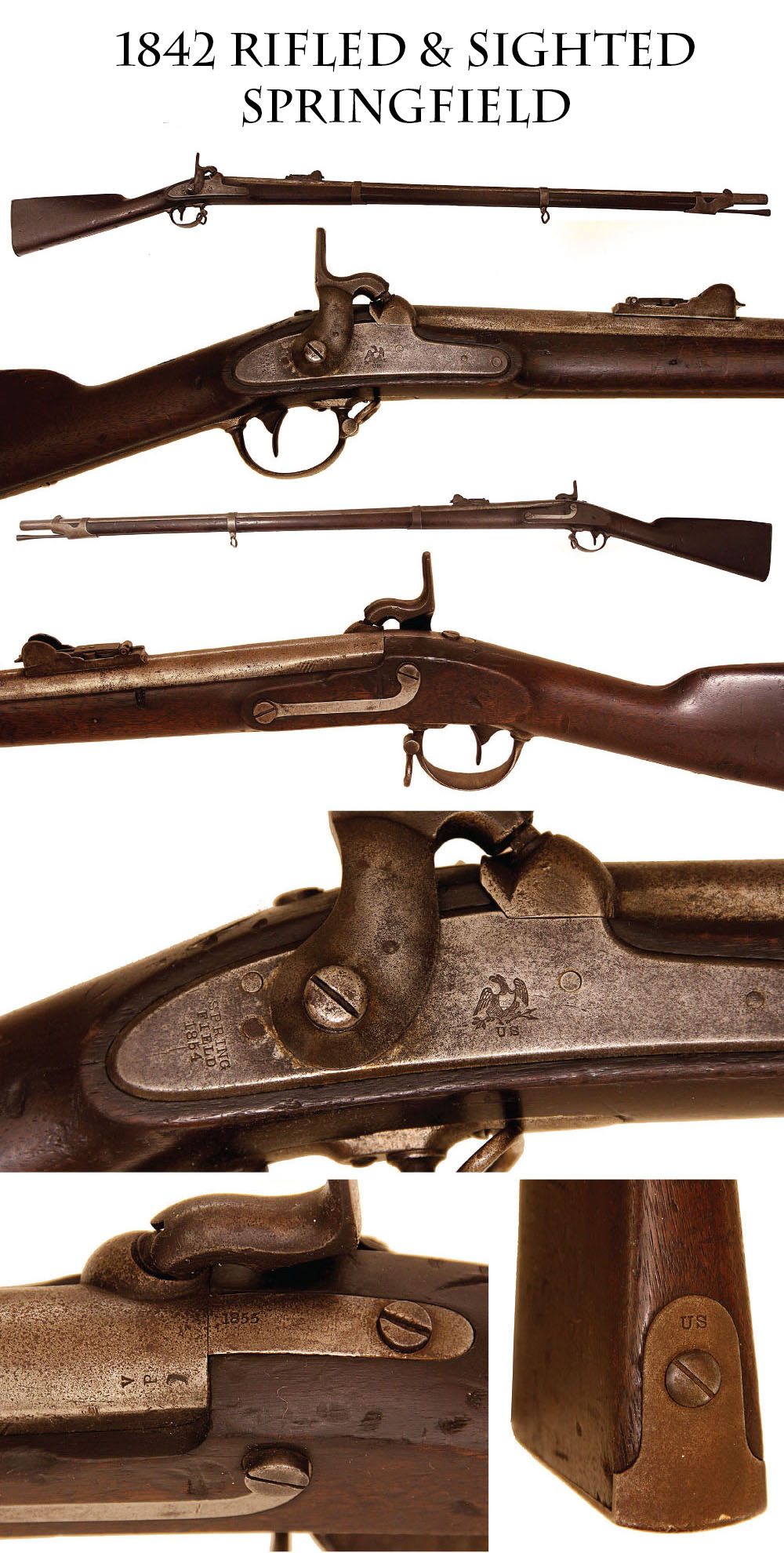
14-01-14 … Very Strong Condition / “Rifled and Sighted” 1842 Springfield Musket:
The Model 1842 was the last of the US .69 caliber smoothbore muskets and the first of the regulation percussion muskets made at the national armories. About 275,000 were made at Springfield and Harpers Ferry between 1844 and 1855. This pattern is a key weapon in a Civil War or US Arms collection. Of the large number made, however, only a small fraction (about 14,000) were rifled, and of those only 10,000 were sighted. The standard ‘42 patterns were returned to the national armories and upgraded between 1856 and 1859 by rifling the bores to accept the newly adopted minie bullet. Of that total of rifled guns fewer than 10,000 had the additional feature of a long range rear sight added as does this nice specimen. Ours is a sharp example with very good edges to the wood and crisp markings. Overall NRA VG++ condition. Very clear V/P/eagle’s head proofs at left side of breech, 1855 breechplug date. Nice eagle on lock plate forward of hammer, Spring/field over 1854 at rear of lock plate. The unmatched 1854/55 dates on the plate and breech plug tang are 100% proper and correct on a rifled gun. All the upgraded muskets were completely disassembled without consideration of date or markings, and after rifling they were reassembled at the armories with no attempt to match the original dates of manufacture. Very minor dings in the wood, metal smooth, generally gray with brown dappling, just very slight salt-and-pepper pitting marks near the nipple and a small vise mark at left breech. Screw slots sharp and unbuggered, rod, swivels, bands and springs all in place. 100% original, 100% complete, and mechanically perfect. Good mechanism and decent bore. These guns saw service from their date of manufacture all the way to the end of the Civil War: we still find 1864 pattern cartridge boxes made for “elongated ball .69 cartridges.” This would be a good addition to a Civil War display and fill a significant gap in a US martial arms collection. The rifled and sighted Model 1842s are a darn scarce piece, and this is much nicer than most
… $1,950.00
Click Here to E-mail Us!
Call us @ 419-842-1863

14-01-15 … Early 1886 Winchester Rifle in 40/82 Caliber w/ Rare Dealer’s Marking:
Early SN 27,722 … made in 1888. The 1886 Winchester incorporated a number of changes from previous models courtesy of John Browning’s arms designs. The gun used a receiver milled from a single piece of forged steel and an improved bolt locking mechanism among other features. The design was simpler, had greater tolerances, operated more smoothly, and was able to withstand heavy charges, making it a favorite of big game hunters such as Teddy Roosevelt. These have a three-piece loading gate for longer cartridges and frequently appears in large calibers and chamberings. Ours rates Fine or darn near it by Flayderman’s NRA standards: all original parts, better than 30 percent finish, sharp markings and lettering, very good bore, only minor handling wear on the wood. Our barrel finish is actually quite fine… at least 60-70 percent plum with just minor rubbing showing some dull gray on the sides, and just a bit less on the magazine tube. Standard round barrel, 26 inches, full magazine, standard Winchester rear sights, and rifle stock configuration with crescent butt plate. Upper tang has the early, simple, “MODEL 1886” marking. Has standard Winchester firm name and address manufacturing stamp without the later used patent dates on top of the barrel. Also bears dealer name “V. Kindler / East Saginaw” (Michigan). Receiver shows striations and faded purple from old case colors, with some mixed dull silver and pewter highlights Good color to bolt. Straight-grained walnut stock, fine wood-to-metal fit, very nice condition, just very minor handling dings. A very honest ’86 that saw “use, but no abuse.”
… $2,395.00
Click Here to E-mail Us!
Call us @ 419-842-1863

14-01-16 … Exceedingly Scarce Napoleonic “Year 13” Pattern French Cuirassier’s Sword By the Famed Paris Workshop then Assembled at Versailles by even more famed Boutet.
Few sights were more thrilling or more terrifying to those on the battlefield than the charge of French Cuirassiers. Mounted on large horses and equipped with helmets and breastplates, the French heavy cavalry, or “cavalry of the line” was intended to charge home on the battlefield, breaking enemy formations at the critical moment of an engagement. Their prime weapon was this long straight-bladed sword that is probably the most widely recognized cavalry saber anywhere. Our example is an early production “Year 13” or “An XIII” Cuirassier sword (the French Revolutionary calendar designation for the year starting September 1804), sometimes also called the “An XI/XIII” because only minor changes distinguished the pattern officially adopted in 1804 from the earlier 1802 pattern. Our blade shows the scarce “AP” blade maker mark of the “Atelier de precision,” sometimes understood as the “Atelier de Paris,” a private blade and sword maker. Also present is the rectangular sunken inspector proof stamp of the “fasces” surmounted by a liberty cap. This marking is found on the earlier “Year 9” pattern blades, but relatively few “Year 11/13” blades. This indicates an early production. As is correct for an “AP” sword, there is no Klingenthal marking on the back of the blade. The hilting shows very clear markings by Boutet at Versailles, who was granted the right to assemble half the production run of this pattern: Klingenthal actually had to send half their blades to him for assembly. The combination of markings shows this was a blade made by the Atelier de Precision under contract or order by the French government and sent to Versailles for hilting. According to one source, “AP” marked blades were considered to be of the highest quality, were used not only on issue swords but also supplied to inspectors as benchmark examples, and are especially associated with the 2nd Cuirassier Regiment. The blade on ours is bright with just a few scattered gray spots. Markings are clear. Tip preserves much of the early regulation clip point that was commonly altered to a spear point in the field (which became the official form in 1816.) The brass is light, but not bright or buffed. Markings again are very legible. Grip leather is present, wire is present and slightly loose. Hilt is tight and washer at blade shoulder is present. Scabbard is smooth steel, overall brown patina, very slight crustiness here and there. The side position throat screw and larger drag are what some collectors term the “1816 pattern” from its official adoption that year, but which was in production as early as 1814 and show up on these Waterloo captured examples. This is a superior example of a very desirable and very rare sword. There are tons of fakes, frauds, forgeries and misidentified versions of this historic sword. Here is one with which you can sleep at night knowing it is “the real deal”. Pieces this nice could even make a Napoleonic collector out of me.
… $2,650.00
Click Here to E-mail Us!
Call us @ 419-842-1863
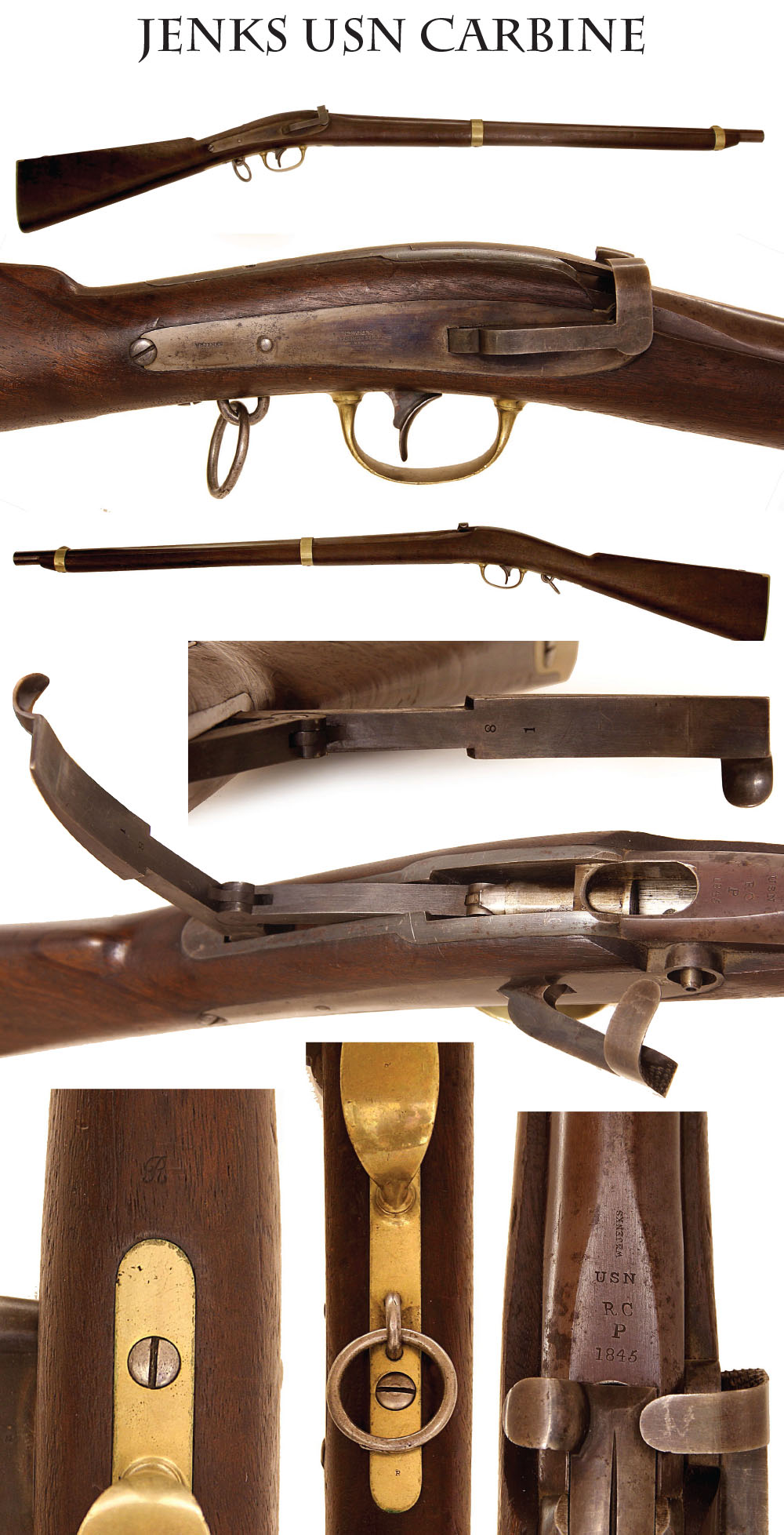
14-01-17 … Extra Fine Condition US Navy Jenks Breechloading “Mule Ear” Carbine Dated 1845 by Ames.
William Jenks designed a number of weapons based on his breechloading patent that used a lever that raised up and drew back a plunger from the breech of the gun allowing insertion of powder and ball or fixed cartridge. His percussion arms used the side hammer or “mule ear” system. Ames made 4,250 carbines for the navy using his design between 1843 and 1846. These are .54 caliber, brass mounted with two barrel bands, the forward one mounting a sight, and a sling ring mounted on the triggerguard tang. This is an 1845 dated example in extra fine condition showing sharp markings and wonderful wood, lots of original factory finish, including case on the lockpate and breech mechanism and loads of lacquer brown on the barrel. Correct oval breech aperture for cartridge loading, rifled bore. “81” assembly number on the underside of the lever. Lockplate shows clear “W Jenks” at rear, “N.P. Ames / Springfield/ Mass” forward. On the breech: “W Jenks” lengthwise and “USN / RC / P/ 1845” denoting the inspector and acceptance by the navy. This is first rate example of a visually intriguing US martial arm. Jenks patterns were the only side hammer arms ever accepted by the government, and this one is in superior condition. You won’t be ashamed to display this gem on your gun rack and you will be hard pressed to find another as nice, particularly at the friendly price of
… $2,950.00 SOLD
Click Here to E-mail Us!
Call us @ 419-842-1863
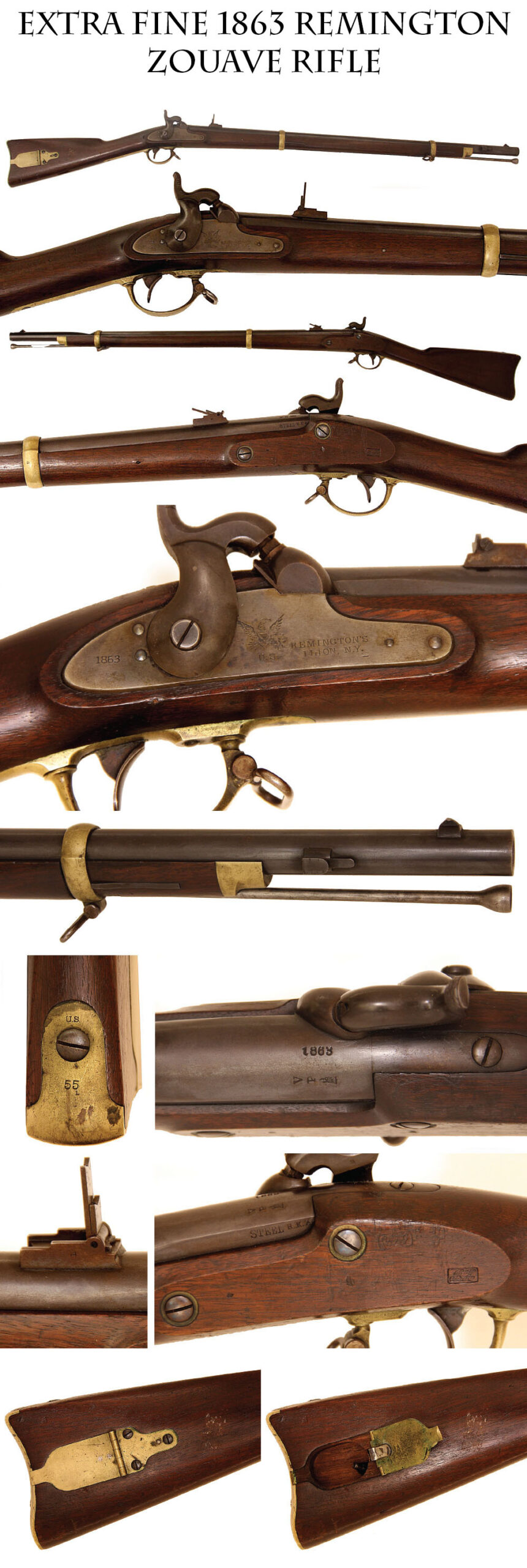
14-01-18 … Extra Fine Condition Remington 1863 Zouave Rifle:
Remington made some 12,500 of these .58 “Harpers Ferry Pattern” rifles between 1862 and 1865. With brass mountings including a patch box and barrel bands, blued barrels, and casehardened locks, they are one of the most attractive US military long arms ever produced. It has long been a mystery who, if anyone, got these arms, but ours may fill in one piece of the puzzle: the butt plate tang shows a rack number “55” stamped neatly into it, apparently indicating it was actually issued somewhere, at some point. Many years ago I thought I had solved the Zouave mystery when I found a recruiting poster for a NY Infantry regiment which, as an inducement, stated that the men were to be armed with the “Remington Rifle”. I excitedly called Mike McAfee over at West Point with the news, but Mike dashed my spirits with his encyclopedic knowledge, informing me the regiment in question was armed with the Remington Model 1841 Mississippi Rifles. The Zouave issuance mystery remained and remains. This is a sharp, investment grade, gun exhibiting very little handling wear. Wonderful muted original factoru blue covers 95% of the barrel, case color shows clearly on the lock plate, nice mellow patina to the brass, sharp edges to the wood, vivid cartouches. Crisp 1863 rear of hammer, eagle over US forward of hammer next to Remington’s / Ilion, N.Y. Crisp 1863 barrel date next to V/P/eagle proof and “STEEL” next to inspector initials. Mint bore. Ramrod, swivels and bands all in place, as is the front sight and two-leaf rear sight and extended bayonet lug for a saber bayonet, all with original blue. These guns well deserve the “Zouave” title that collectors gave them because of their showy character. (As an aside, the white buff leather rifle slings long thought to be for Mississippi rifles with Civil War era inspector stamps were in fact, likely intended for issue with the Zouave rifles. Both items turn up in near mint condition.) The rifles are beautifully proportioned and have handsome lines. When mounted with their brass handled saber bayonets they are truly a ferocious looking weapon
… $3,450.00
(call for bayonet availability)
Click Here to E-mail Us!
Call us @ 419-842-1863

14-01-19 … Whitney Revolver #15771
Whitney Pocket Revolver
– Tight and solid with 5 inch octagon barrel. Overall VG+ condition. All steel is bright having been cleaned some years ago. Gun is 100% original, 100% complete, and mechanically perfect. Grips are fine. Markings are sharp. .31 caliber, 5″ barrel with “E. WHITNEY N. HAVEN” on the top. SN 15771. The cylinder scene is only partially and faintly visible. Man a Union soldier carried a Whitney revolver with him in the field. An honest and affordable example, and desirable with the five inch barrel
… $750.00 SOLD
Click Here to E-mail Us!
Call us @ 419-842-1863

14-01-20 … North Carolina Battlefield Walking Stick:
A fine early battlefield souvenir with inscribed silver cap circa 1900. The silver cap is marked in classic 1890-1910 fashion … Edward P. Smith Co. E 44thRegt. MVM / Rawles Mills NC Nov. 2, 1862. Rawles Mills was the first battle action seen by the 44th. Here is a recap of the regiments service … Expedition from Newberne November 2-12, 1862.
Action at Rawle’s Mills November 2.
Demonstration Newberne November 11. Foster’s Expedition to Goldsboro December 11-20. Kinston December 14. Whitehall December 16. Goldsboro December 17. At Newberne until February 10, 1863. Moved to Plymouth, N. C., February 10, and duty there until March 15. (Cos. “B” and “F” detached on outpost duty at Batchelor’s Creek February 10 to May 1.) Skirmishes Deep Gully, Newberne, March 13-14 (2 Cos.). Regiment moved to Washington March 15. Siege of Washington March 30-April 20. Skirmish at Washington March 30 (Cos. “A” and “G”). Skirmishes at Washington April 3 and 15. Expedition from Newberne to relief of Little Washington April 7-10 (2 Cos.). Regiment moved to Newberne April 22-24, and duty there until June 6. Expedition toward Kinston April 27-May 1. Dover Road April 28. Moved to Boston, Mass., June 6-10. Mustered out June 18, 1863. Undoubtedly soldier Smith returned to the early battlefield in his later years, clipped a branch from a battlefield tree, and manufactured himself a fine walking stick. Nice piece of veterans folk art. D-rp
$450.00 SOLD
Click Here to E-mail Us!
Call us @ 419-842-1863
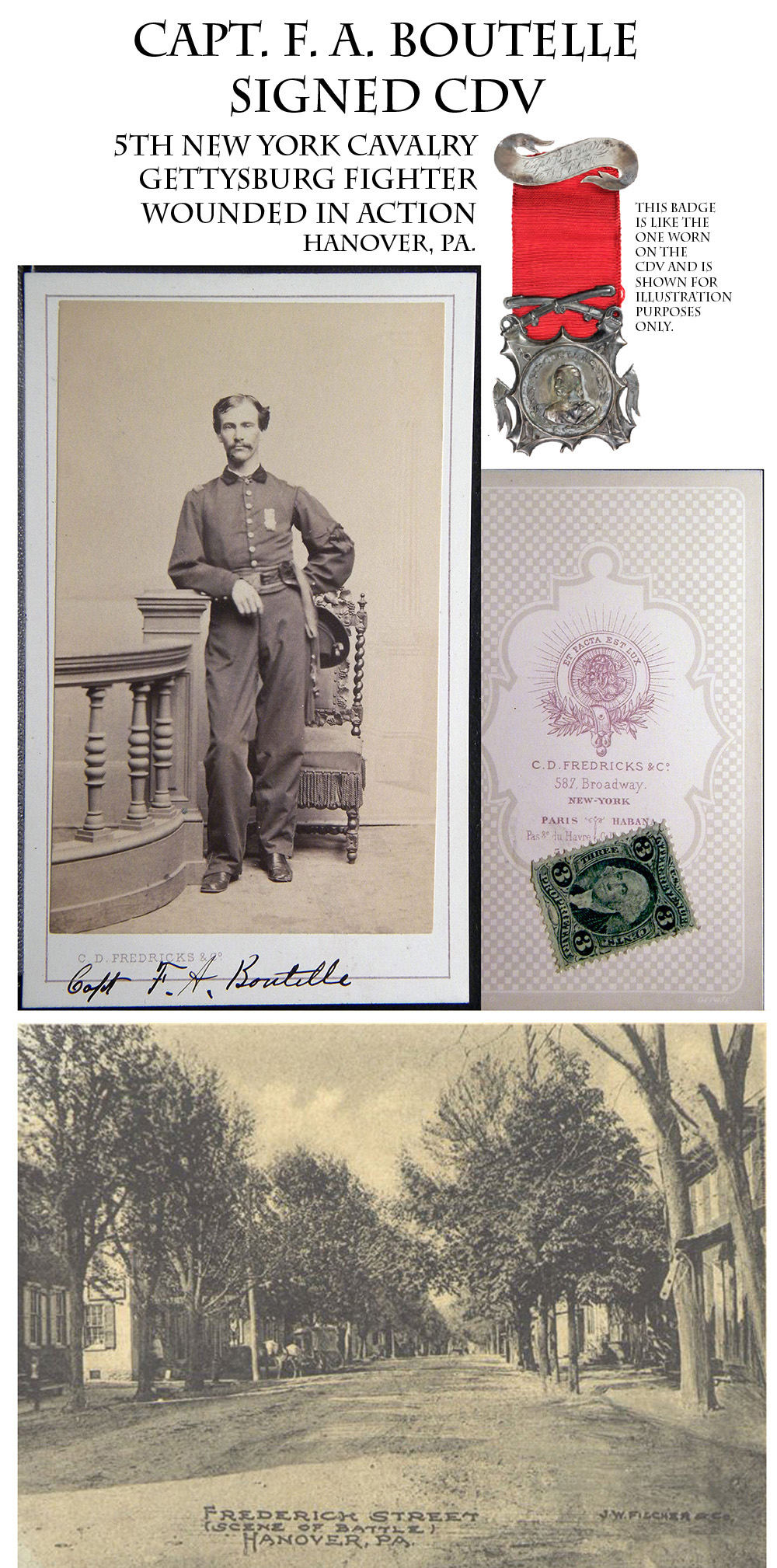
14-01-21 … CDV Cavalry War Hero Wearing Custer Brigade Badge / A Gettysburg Casualty / An Indian Fighter /
Wounded at Hanover June 30, 1863; Also brevetted for “conspicuous gallantry” against Indians in 1872! Wonderful Full standing CDV portrait by Fredericks, NY, signed in ink at the bottom front: “Capt. F. A. Boutelle.” Typical elaborate Fredericks backmarked card with tax stamp. Boutelle is shown leaning on a studio railing with a chair behind him. His left hand on his hip holds his slouch hat partly behind him. He wears an officer’s short jacket with shoulder straps and turn-down collar, dark trousers, an officer’s sash and fairly fancy officer’s belt showing belt plate and saber slings. He wears the exceedingly rare Custer Cavalry Division badge on his left breast which consists of a scroll top bar usually engraved with the owner’s personal data. Below this is suspended a ribbon, then crossed saber devices, then a large medal with Custer’s likeness. He also has a mourning ribbon on his left sleeve, likely for Lincoln. Boutelle has an interesting record that spans fifty-seven years of army service. Born in Troy, NY, in 1840, Frazier Augustus Boutelle enlisted in the 5th New York Cavalry (The Ira Harris Guard) at age 20 in New York City on 8/15/61. He was the first recruit mustered into Co. A, and was appointed Quartermaster Sergeant the same day. He made 2nd Lieutenant 11/5/62, 1st Lt. 4/2/64, and Captain 1/10/65. The regiment was extremely active in the Shenandoah, against Mosby, and in the Army of the Potomac. CWData has more than 170 entries for occasions where they were engaged or lost men and records 8 officers and 93 enlistedmen killed or mortally wounded, which is very high for a cavalry outfit.
Boutelle had a number of close calls. On May 30, 1863, he was part of a group that pursued Mosby, who had just attacked and destroyed a railroad train with the help of captured howitzer. The gun was eventually recaptured, but not before one of its shells struck the pursuing riders, killing Boutelle’s horse under him. Just a month later during the Gettysburg Campaign Union and Confederate cavalry skirmished constantly to discover and conceal troop movements and the 5th NY, part of Farnsworth’s First Brigade of Kilpatrick’s Third Cavalry Division, was paused in the streets of Hanover, PA, when the rear of the brigade was attacked and driven into the town in confusion. The 5th NY rallied near the railroad depot and charged back into town engaging in hand-to-hand fighting on Frederick Street, during which Boutelle was wounded. In January, 1864, he was appointed First Brigade chief of ambulances for the 3rd Cavalry Division, and promoted to First Lieutenant in April. He reenlisted at expiration of his term of service and returned to the regiment as Captain in January, 1865, serving with them to the end of the war. He mustered out with the regiment 7/19/65 at Winchester, Va.
Army life apparently agreed with Boutelle: he reenlisted in the regular army, signing up as a private in Company F of the 1st US Cavalry in February, 1866, and working his way back up to a commission, rising to corporal, sergeant, regimental sergeant major and then 2nd Lieutenant in early 1869. He served in Idaho and elsewhere on the frontier against Indians, mainly Apache, Piute, Snake, Modoc and Nez Perce in Arizona, California, Department of the Columbia, Montana and Dakota. In 1872 he saw action in the Modoc War in Oregon, being assigned to arrest Captain Jack and other Modoc warriors, engaging in a personal exchange of gunfire with “Scarface Charlie,” taking part in several scouts and fights. Boutelle in 1890 received a retroactive brevet to 1st Lt. for “gallantry in action against Indians at Lost River Oregon November 29, 1872, and conspicuous gallantry and meritorious conduct during the whole Modoc war.”
He was promoted 1st Lt. July 31, 1873; Regimental Adjutant May 25, 1875 to Oct. 16, 1877; and Captain of Company K April 24, 1886; retired Aug. 27, 1895.
Boutelle also gained fame as a conservationist during the army’s supervision of Yellowstone National Park, acting as superintendent from 1889-1891 and being instrumental in preserving the bison in the park, restocking fish, and reducing forest fires by the novel idea of restricting campers to camp grounds. On retirement from the army in 1895, Boutelle served for two years as head of the Oregon National Guard, instituting a number of reforms, and then returned to army service as a recruiter in 1905, being advanced to the rank of Colonel on the retired list, a duty he performed through World War One, retiring from military life a last time only in 1919. He died in 1924. Boutelle had one child, Henry, who became an officer in the 3rd Artillery during the Philippine Insurrection and was killed in an ambush while serving with the Macabebe Scouts in 1899.
A nice CDV of a significant Civil War and Indian War cavalryman. Compared to the Gettysburg relic shop prices of $350 and up for any soldier who was present at Gettysburg, $1000 and up for WIA soldiers and $2000 and up for KIA Gettysburg soldiers… this fantastic “from life” hero’s photo, with a truly exciting biography, is a terrific value at
… $595.00 SOLD
Click Here to E-mail Us!
Call us @ 419-842-1863

14-01-22 … 1860 Douglas / Johnson Jugate Political Token / A Period Error:
A neat relic of the 1860 election. I guess the most interesting aspect of this piece is that the manufacturer inserted the wrong ferrotype portrait on the Douglas side, using John Bell’s likeness instead. The Johnson portrait is correct and quite rusted & bubbled. The Bell portrait is excellent. The token maker produced examples for all the candidates so the portrait mistake is understandable. Bell political items are incredibly rare, and his portrait here is unique in my experience. A period “error” and a wonderful relic of the Lincoln election. If such an error were committed on a coin or stamp the value of the coin or stamp would be astronomical. (Reference the inverted Jenny airmail stamp of 1918, and the 1955 double-die Lincoln penny.) Here it makes the item most affordable. Go figure
… $325.00 SOLD
Click Here to E-mail Us!
Call us @ 419-842-1863
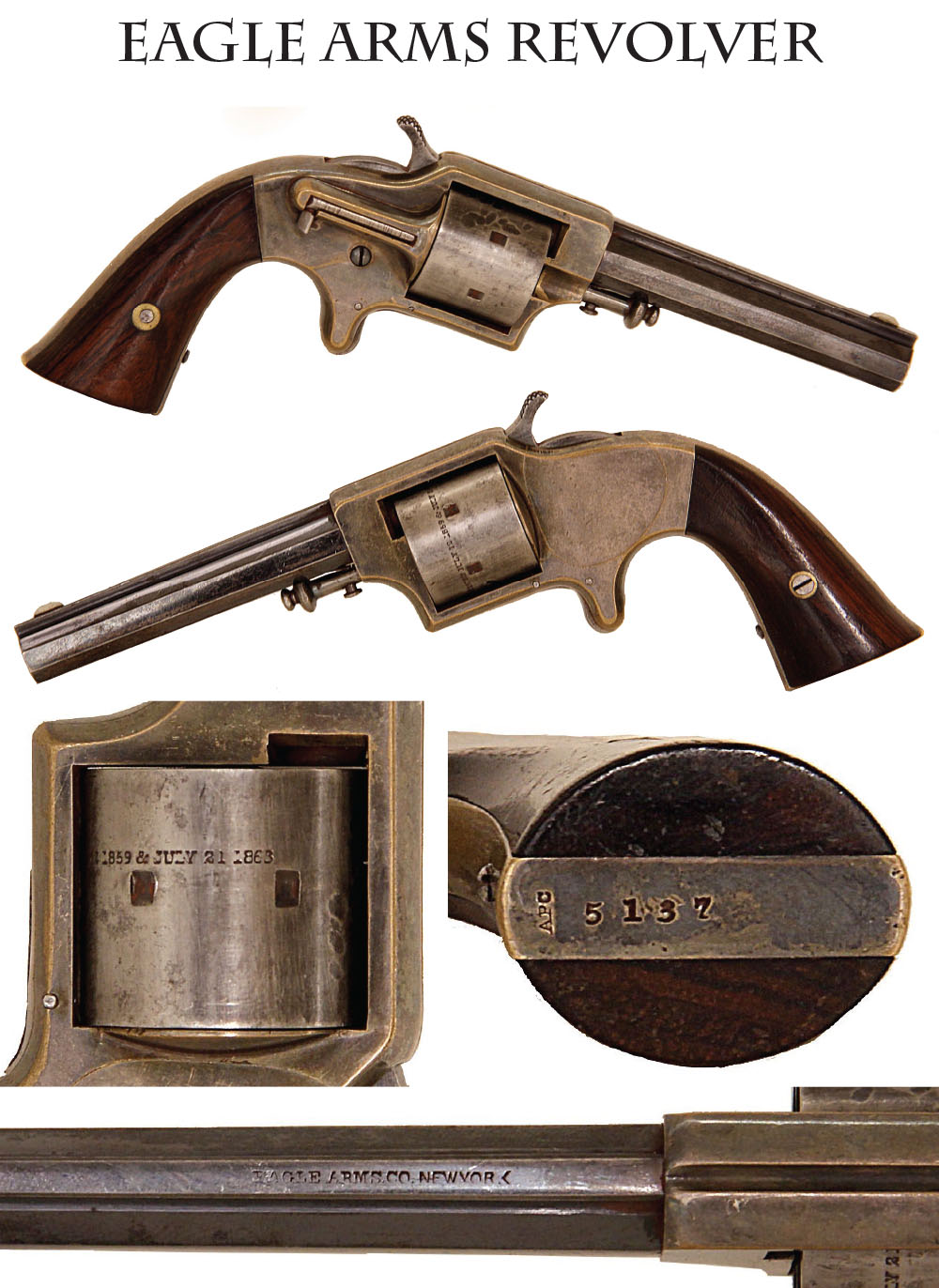
14-01-23 … Fine Condition Plant’s Mfg. Co Pocket Revolver aka Eagle Arms –
These diminutive revolvers were produced by the Eagle Manufacturing Company of NY City and are found with various barrel markings. This one is marked “Eagle Arms Co. New York.” on the top of the octagonal barrel. Serial number #5137 on the cylinder and the butt strap. It is a 30 caliber 5 shot revolver… overall Fine condition being 100% original, 100% complete, and mechanically perfect. Rosewood grips are fine+. Generous silver plate remains on the brass frame, as does much factory blue on the barrel. Cylinder nicely marked and grey steel. Many were carried as backup weapons during the war and by many western gamblers as well … Extra nice condition, much better than most we see
… $750.00 SOLD
Click Here to E-mail Us!
Call us @ 419-842-1863
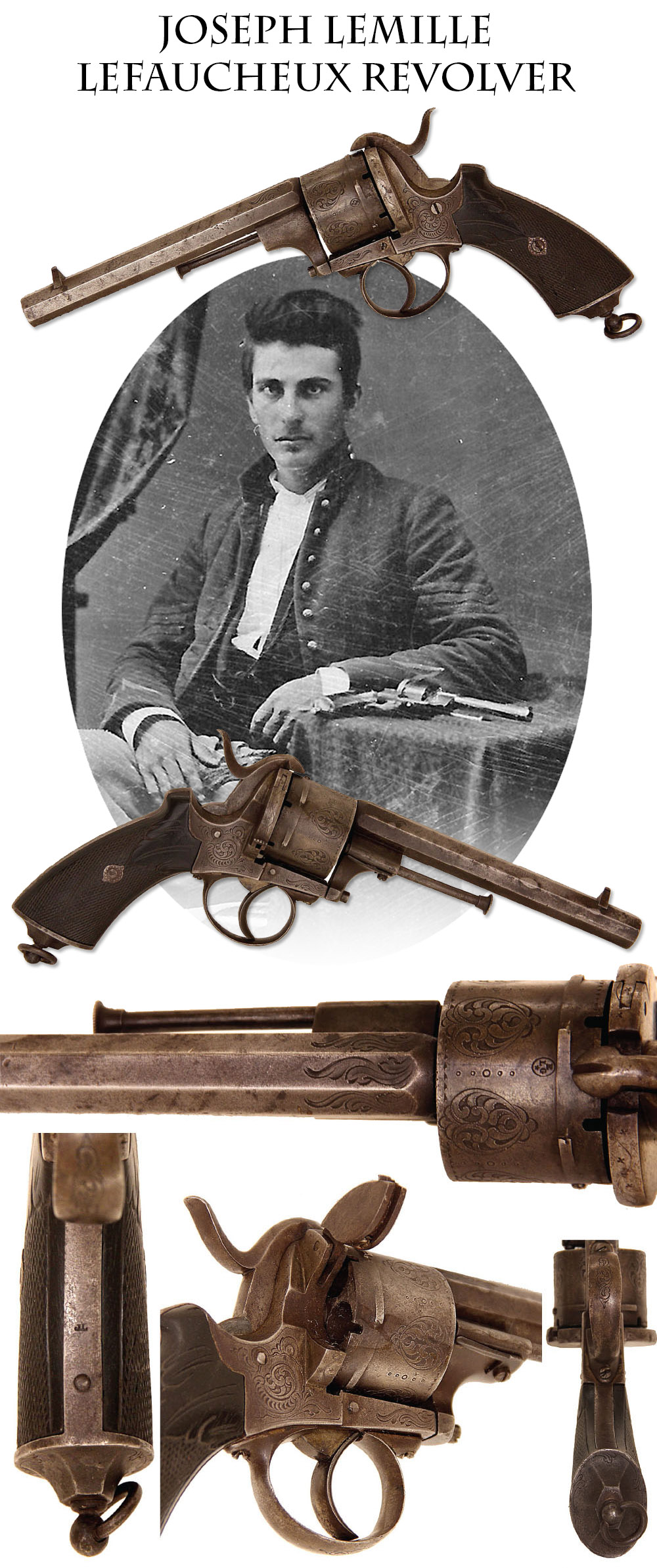
14-01-24 … Lefaucheux Pattern Revolver made by Joseph Lemille:
French Made Joseph LeMille Revolver. This large frame, engraved, 12mm revolver is a 6 shot pin-fire and has an octagon barrel that is 6″ in length. About identical to the famed French Lefaucheux made revolvers carried North and South, I do not know if Lemille was making these under license or if he claimed some independent patent. Totally unmarked except for “JL” on grip strap. Grips are finely checkered and look to be ebony. Steel surfaces are nicely hand engraved. Bore is average. Loading gate latch is missing. The gate is present, just the little “catch” is missing. Action works properly. Gun is 100% original and mechanically perfect. A lot of these early French pistols were imported by the Confederacy. Lemille’s name is found on percussion carbines and rifles, mostly of the 1850s era. He lived 1811-1882, manufactured weapons in Liege and was the son of a soldier of the empire. His company was registered with the proof house of Liege from1836 to 1874. At the end of his lifetime, he bequeathed the hotel of Hayme de Bomal quay of Maastricht to the town of Liege. ;This splendid building became the Liege Arms Museum. His widow bequeathed an important collection of weapons (500) which is still preserved by the museum. This is the first Lemille revolver I have owned, which makes me think they must be on the scarce side. It turned up at a Cleveland, Ohio auction. Signed “JL” on inner steel strap.
… $875.00 SOLD
Click Here to E-mail Us!
Call us @ 419-842-1863
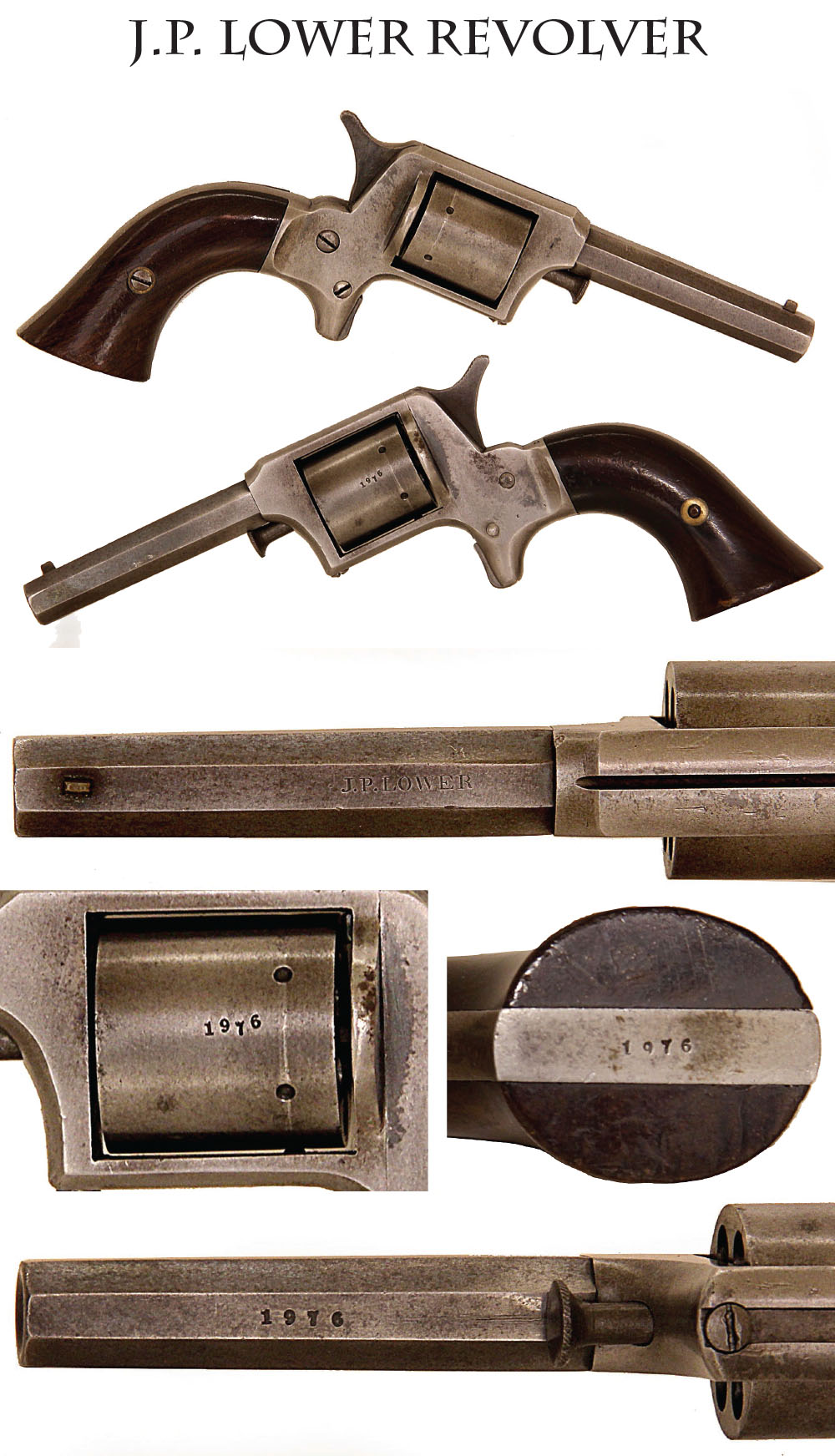
14-01-25 … “J.P. Lower” – Wonderful Little 1860’s Uhlinger 22 caliber Revolver Bearing “J.P. Lower” Barrel Legend
– This is the scarce solid frame Uhlinger 22 caliber revolver with a 3 inch octagonal barrel. It has all matching serial numbers (1976), and is 100% original and mechanically complete. The rosewood grips are in fine condition while the rest of the gun is VG+ to near fine with hints of blue here and there. Uhlinger basically bought out William Hankins when he went into business with Christian Sharps in 1861. Uhlinger got all the tools and the “stock-in-process”. He then made thousands of small revolvers in 22 and 32 caliber … but sold them under various names as he was infringing on patents held by Smith & Wesson. He marked this one with name of J.P. Lower who was at the time a small time gunsmith but later in life became a famous Denver Colorado gun dealer and outfitter. This is a nice spur trigger small caliber pocket revolver perfect to display with Civil War soldier effects or western gambler items.. Near fine condition and interesting with the Denver connection
… $595.00 SOLD
Click Here to E-mail Us!
Call us @ 419-842-1863
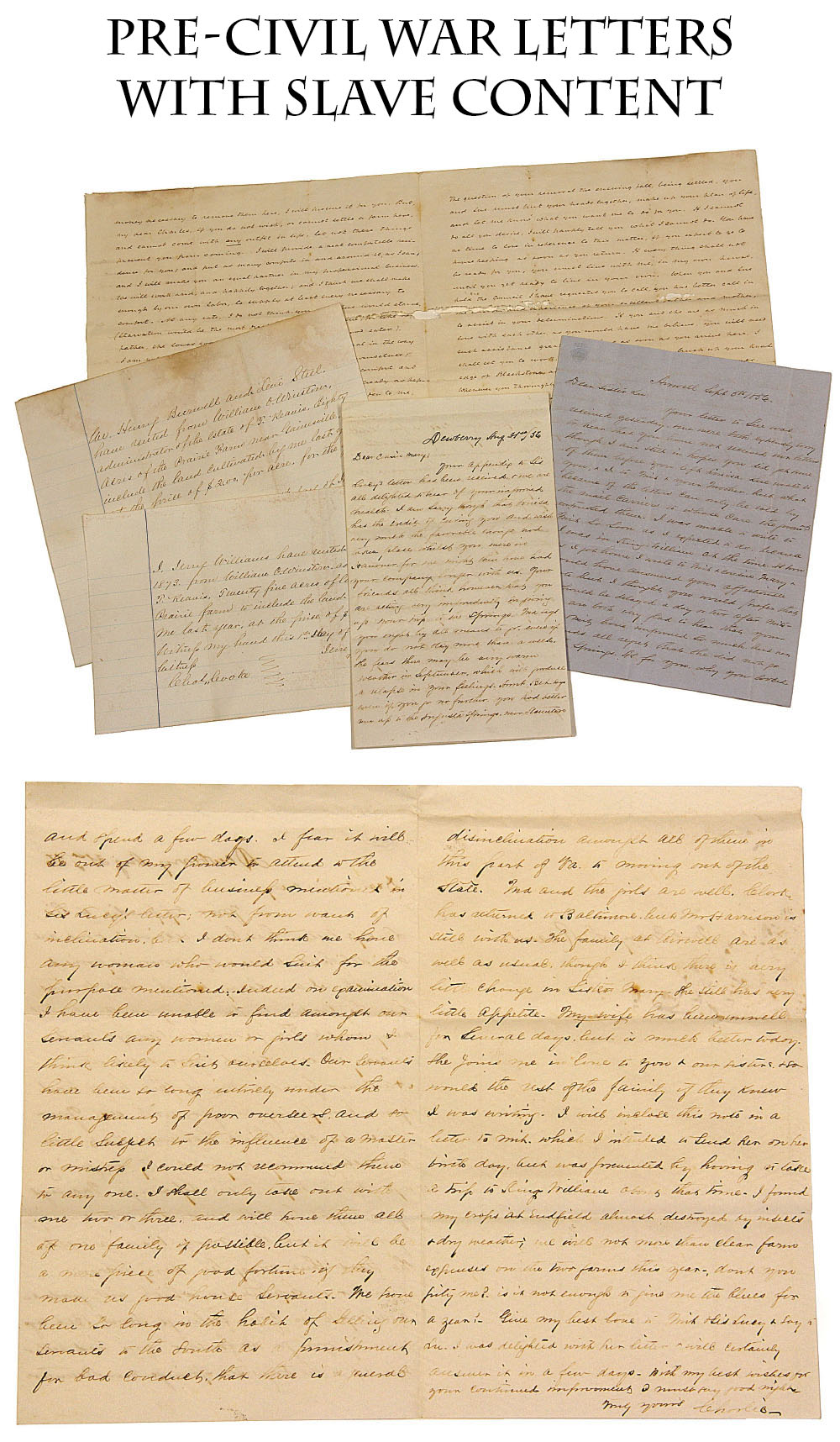
14-01-26 … Southern Letters w/ Slave Content.
Three pre war four page letters circa 1856 and two 1870s receipts. All three pre war letters are interesting with news from Virginia and Alabama. The cream of the lot is a letter dated Dewberry Aug. 31st 1856 from Charles Cook to his cousin. It starts out with family news and then includes the following unabashed commentary … “… I fear it will be out of my power to attend to the little matter of business mentioned in Sis’ Lucy’s letter, not from want of inclination but I don’t think we have any woman who would suit for the purpose mentioned. Indeed, on examination, I have been unable to find amongst our servants any women or girls whom I think likely to suit ourselves. Our servants have been so long entirely under the management of poor overseers and so little subject to the influence of a master or mistress, I could not recommend them to anyone. I shall only take out with me two or three and will have them all of one family if possible, but it will be a mere piece of good fortune if they make us good house servants. We have been so long in the habit of selling our servants in the South as punishment for bad conduct that there is a general disinclination amongst all of them in this part of Va. to moving out of the state…” I believe that section of that one letter is worth triple the price of admission to this lot. One hell of a piece of manuscript slave history from the Southern point of view. For the lot
… $595.00 SOLD
Click Here to E-mail Us!
Call us @ 419-842-1863

14-01-27 … L. W. Pond, Pocket Model Revolver,
.32 Rimfire, 6″ Barrel, Year of manufacture about 1863 – before Smith & Wesson sued them and won the rights to all their guns and equipment. SN 671 About fine condition overall. 100% original, 100% complete except for ONE of the removable chambers … five are present, mechanically perfect. Traces of factory finish present mixed with superb undisturbed age patina. Super grips. Much nicer than most you will find
… $795.00 SOLD
Click Here to E-mail Us!
Call us @ 419-842-1863

14-01-28 … Serial # 26 – E. A. Prescott Brass Frame Long Barrel 32 Caliber Revolver
– This 32 caliber 6 shot revolver has the rare 5 inch rifled barrel. The octagonal barrel is marked “ E.A. PRESCOTT WORCESTER, MASS. / PAT. OCT. 2, 1860” … has proper blade style front sight. Interestingly this gun bears ultra low serial # 26. The grips are in superb condition and fit perfectly to the frame. Cylinder retains near all its factory blue. This gun has a very cool split-type cylinder pin with an integrated locking mechanism and makes for easier loading and unloading of the cartridges. The color (patina) on the brass is magnificent … the best … undisturbed bronze color… could not be improved upon with prayer. Hints of finish on barrel. Tight action. Good bore. A darn scarce revolver in a really beautiful state of preservation.
… $1,295.00 SOLD
Click Here to E-mail Us!
Call us @ 419-842-1863

14-01-29 …
Wonderful Ninth Plate Thermoplastic Case With Charming Portrait Of Young Lady
dressed in her 1862 finest. posed in front of a photographer’s countryside backdrop. 2 1/2″ x 3″
… $75.00 SOLD
Click Here to E-mail Us!
Call us @ 419-842-1863
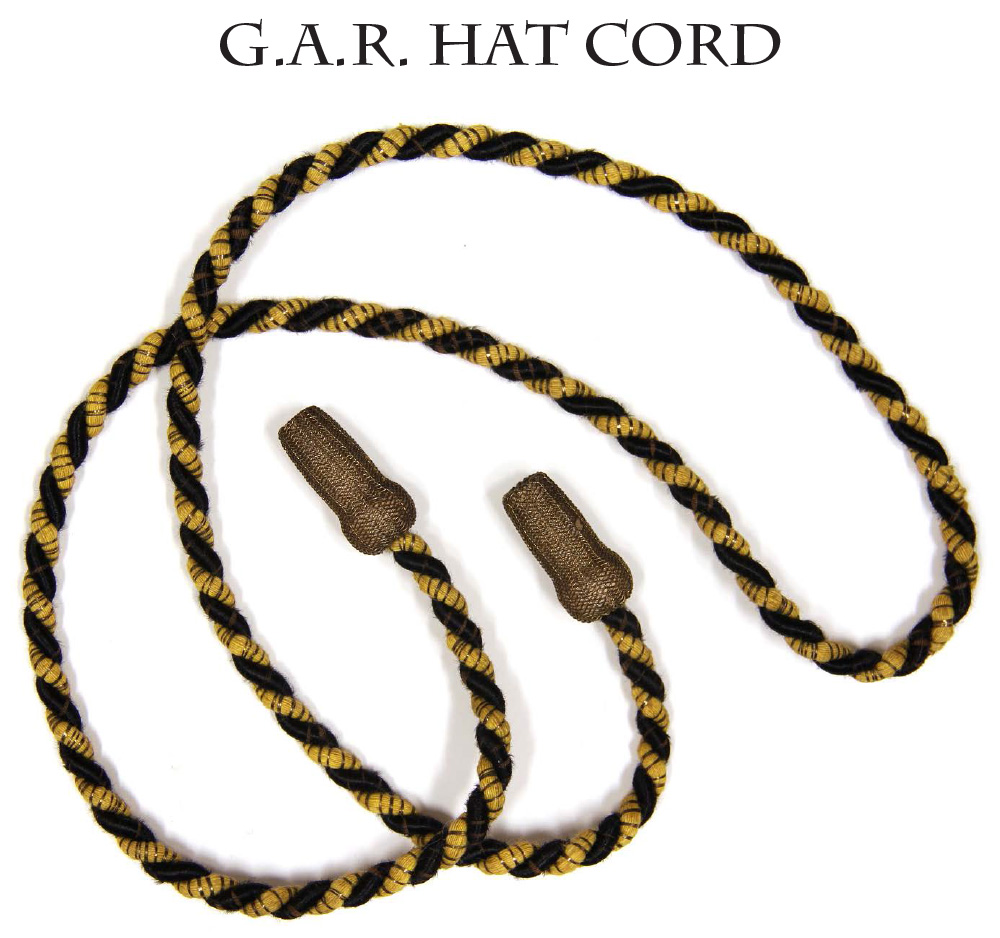
14-01-30
… GAR Hat Cords:
Standard CW vets cords for use on the old time GAR hats that the old timers wore to their reunions. VG condition
… $39.00 SOLD
Click Here to E-mail Us!
Call us @ 419-842-1863
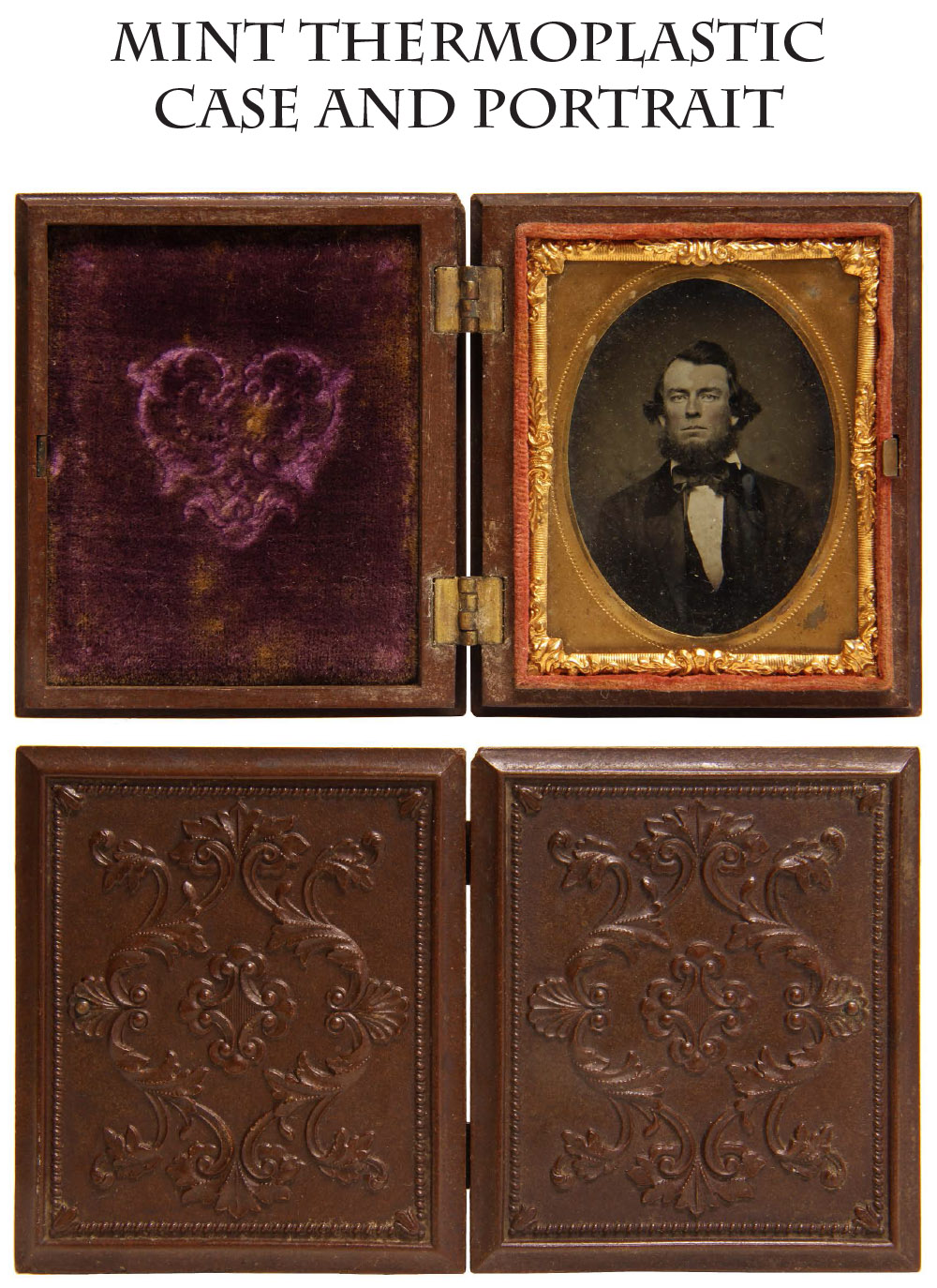
14-01-31 …
Superb Sixth Plate Thermoplastic Case
and fine Civilian tintype inside. Top notch case
… $85.00 SOLD
Click Here to E-mail Us!
Call us @ 419-842-1863

14-01-32 … Exquisite Quality Infantry Officer’s Embroidered Insignia for the Dress Hat!
They literally do not come any better than this! If you want to know what a Civil War officer saw and felt as he opened that box from Schuyler, Hartley and Graham or Horstmann, this is it. Fantastic condition oval velvet backed gilt embroidered infantry horn with wire border and silver embroidered number 2 in the middle indicating the Second Infantry of a state or the US regular army. The horn is that nice fat embroidery we like that denoted a quality product. The interior metal stiffener plate is in place, as is the cloth backing and both loops. As with the eagle side plate offered elsewhere on this list, this is a key piece of insignia and would look fantastic with that uniform or fancy officer’s sword. I can’t think of the last time I had one even coming close to this in terms of rich quality and superb condition
… $775.00
Click Here to E-mail Us!
Call us @ 419-842-1863

14-01-33 … Regulation Union Army Staff Officers Hat Wreath:
One of the scarcer pieces of bullion embroidered insignia from the Civil War is this US Staff wreath. This one is medium large size, just under three inches across. Front has standard wreath with Olde English US inside the wreath. Back is a raw back with exposed threads. Back also shows where it was glued to a display board at one time. Darn rare piece of insignia.
$350.00
Click Here to E-mail Us!
Call us @ 419-842-1863

14-01-34 … CDV Gen. Rosecrans:
Good Brady/Anthony card of “Old Rosey,” ankles-up view of the general in his brigadier general’s frock coat with his officer’s overcoat partly thrown back over one shoulder to show his general’s star and his right hand tucked Napoleonically into his lapel. West Point class of 1842, he left the army in 1854 and returned at the beginning of the Civil War. Successfully maneuvered Lee out of the future West Virginia, succeeded Pope and was first commander of the Army of the Cumberland. Repulsed Bragg at Murfreesboro and took Chattanooga before Chickamauga effectively ended his military career. A very interesting general. Years ago I had an outdoor CDV of mounted officer’s on Rosecrans staff. That card was marvelously inscribed “Rosies Ponies”. (Wish I knew where that photo is now.) His nickname of “Rosey” was the real deal. Minor tape stain bottom reverse.
$49.00 SOLD
Click Here to E-mail Us!
Call us @ 419-842-1863
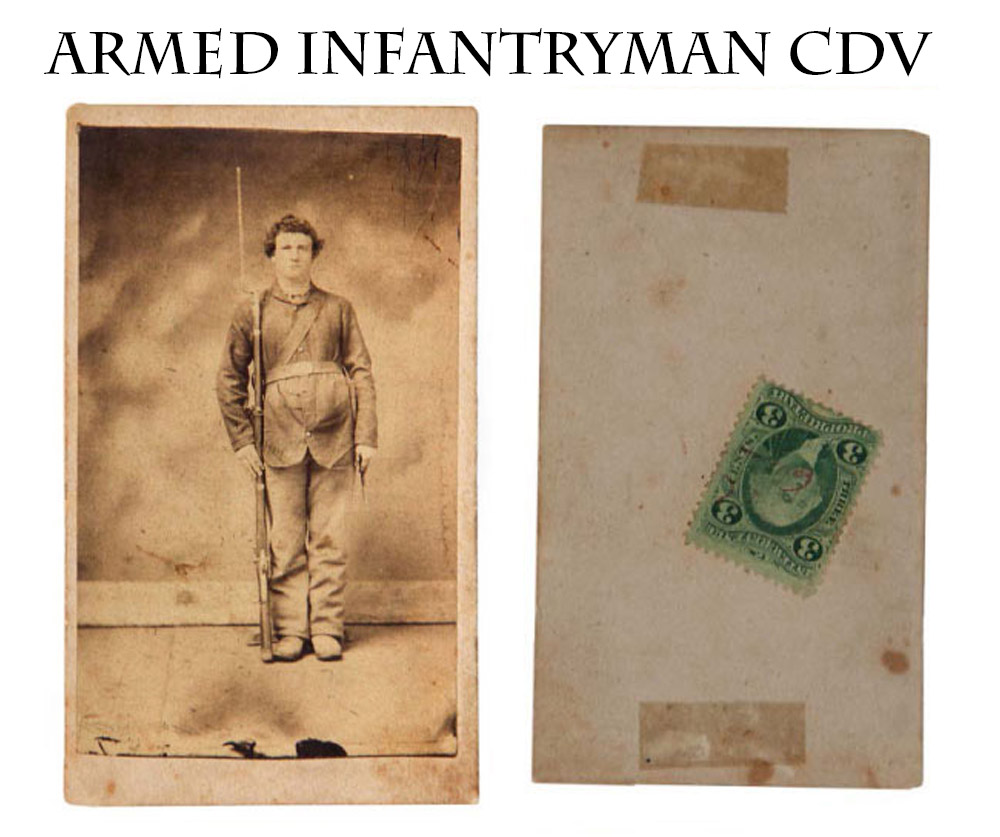
14-01-35 … CDV Classic Yankee Armed Infantryman:
This guy was not much for show in his choice of uniform or photographer’s studio. Bare-headed, he wears a four-button fatigue blouse with his bayoneted rifle at his side, cartridge box sling crosses his chest, his waist belt showing his oval US plate is hitched high up forcing something he stuffed into his blouse pocket way down, creating a very odd bulge. Tip of his bayonet scabbard just visible below his left hand. Very plain backdrop hangs down to the wide-planked bare wood floor of the photographer’s studio or shack. Two minor tape stains reverse with tax stamp. This is the typical Yankee soldier posed with no pretense.
$85.00 SOLD
Click Here to E-mail Us!
Call us @ 419-842-1863
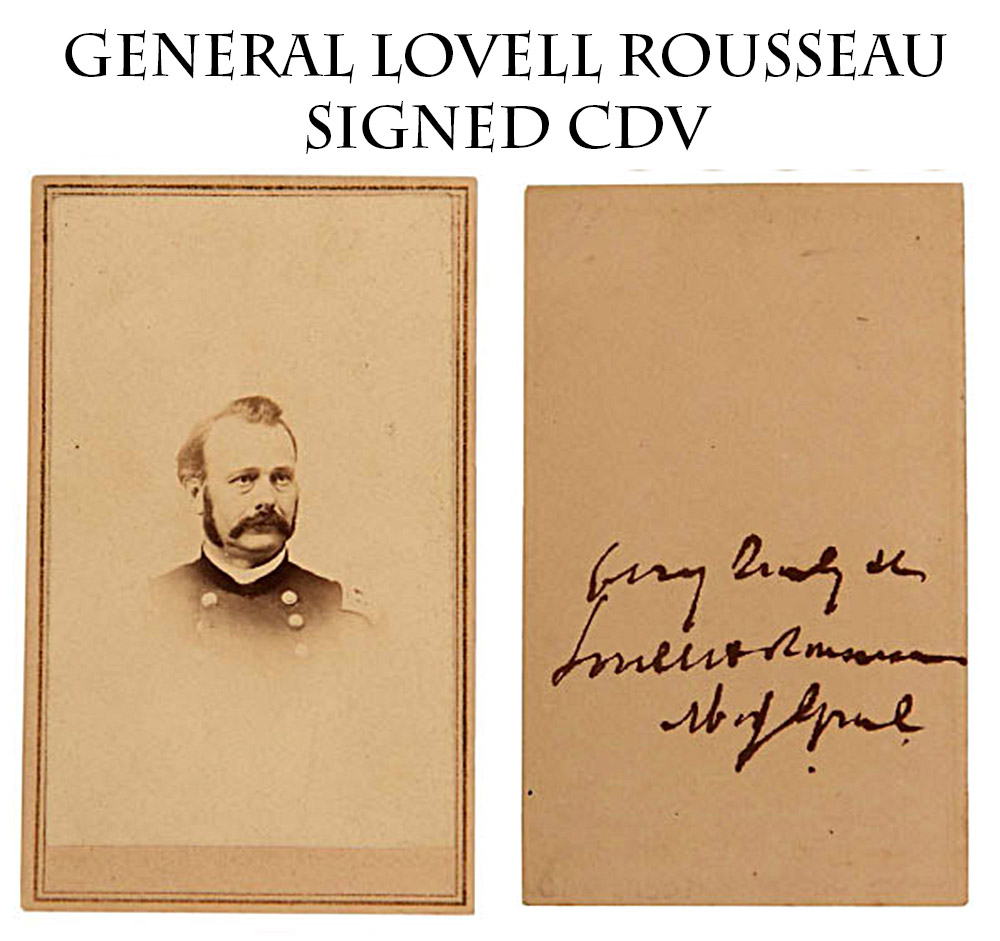
14-01-36 … Autographed CDV Photo of General Lovell Rousseau:
Fine bust portrait in his major generals uniform nicely signed on the reverse in brown ink. He was appointed colonel of the 5th Kentucky Volunteer Regiment in September 1861 and was soon promoted brigadier general of Volunteers attached to the army of General Ormsby M. Mitchel. He was again promoted to major general of Volunteers. He served valiantly at the Battles of Shiloh, Stones River, Chickamauga, the Tullahoma Campaign and movements around Chattanooga, Tennessee. He commanded Nashville from 1863 to 1865 and on Sherman’s orders, carried out a very successful raid on the Montgomery and West Point Railroad in July 1864 Rousseau was elected an “Unconditional Unionist” to the United States House of Representatives in 1864, serving from 1865 to 1866. In June 1866, relations between Rousseau and Iowa congressman Josiah Bushnell Grinnell became tense. On June 14, 1866, Rousseau approached Grinnell in the east portico of the capitol building after a session of congress. He told Grinnell that he had been waiting for an apology from him for the insults he made about him before the House. Grinnell pretended not to know what Rousseau was talking about, enraging Rousseau who struck him repeatedly with the iron handle of his cane until it broke. Rousseau was reprimanded for his actions and soon later resigned. He was elected back the same year to fill the vacancy caused by himself and continued to serve until 1867. He died in New Orleans in 1869. A scarce autographed photo
$295.00
Click Here to E-mail Us!
Call us @ 419-842-1863
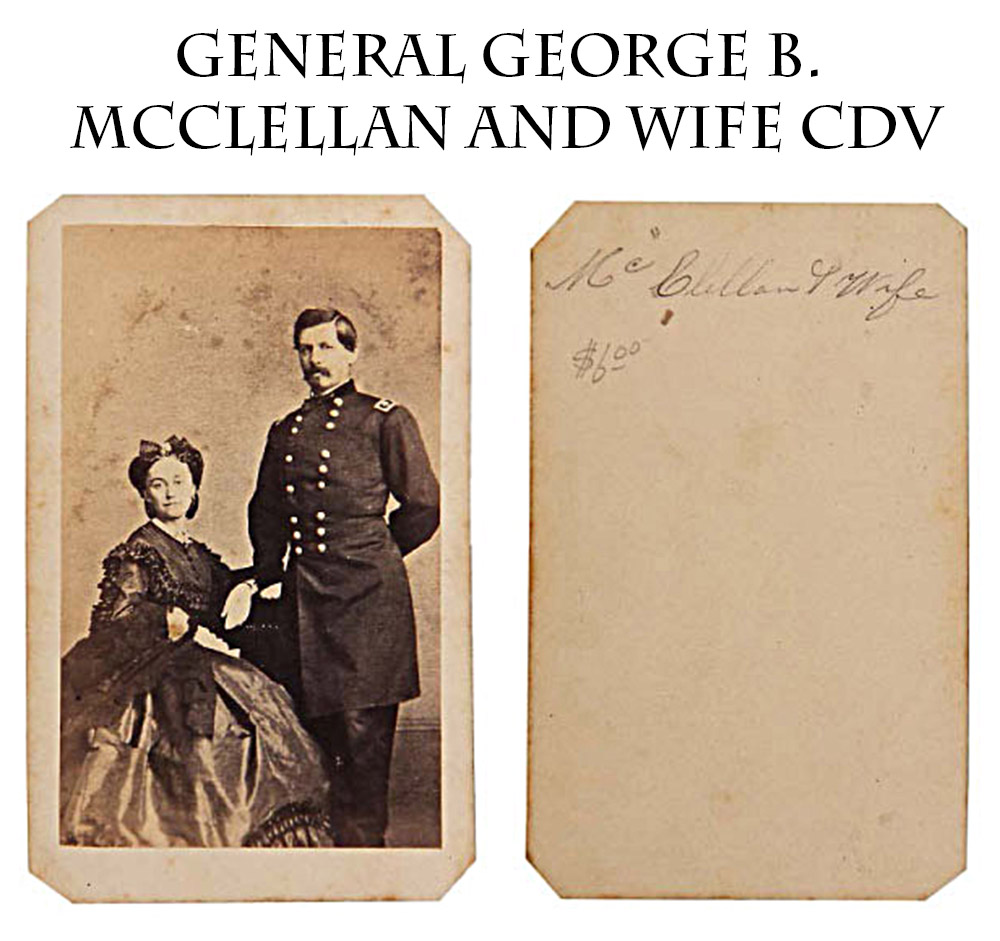
14-01-37 … CDV Photo of General George B. McClellan and Wife:
A fine portrait of the commander of The Army of the Potomac. His men loved him, but he was so disrespectful to Lincoln that I wish someone would have shot him. A fine image of a most historical figure…
$39.00 SOLD
Click Here to E-mail Us!
Call us @ 419-842-1863
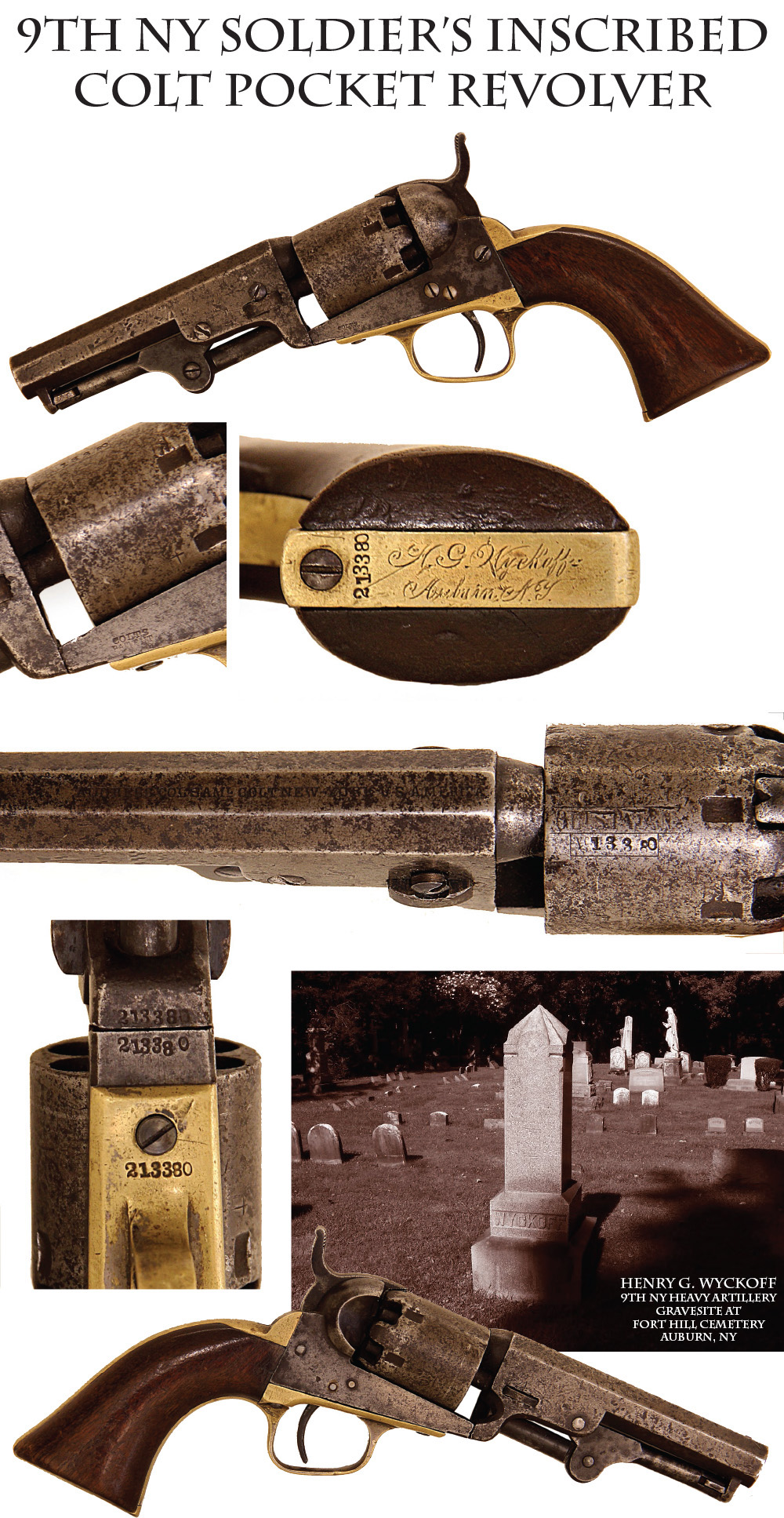
14-01-38 … Inscribed 9th NY Heavy Artillery Soldier’s Colt Pocket Revolver …
This pocket revolver was owned by Henry G. Wyckoff who enlisted in the NY 9th New York Heavy Artillery in August of 1862 and served through April 1864, at which time he transferred into the Veteran Reserve Corps. He and the rest of his company spent the early years of the war stationed in Washington D.C. and were responsible for the defense of the city. By 1864 Grant sent the heavy artillery boys to the front as infantry. Wyckoff lived until 1901 and was survived by his widow. The pistol has all matching early war serial numbers 213,380 and is 100% original & complete and is mechanically perfect. The walnut grip is in very good condition with just some light handling wear. The frame, cylinder, and barrel all have a speckled grey steel patina. The brass backstrap has an attractive patina, and the engraving on the butt is executed in fine Spenserian script carrying Wyckoff’s name and home town. The 9th NYHA left the State September 12, 1862, and served as infantry and heavy artillery in the defenses of Washington, D. C., north of the Potomac, from September, 1862; in the 2d, and later 3d, Brigade, Haskins’ Division, 22d Corps, from February, 1863; the 1st and 3d Battalions in the 2d Brigade, 3d Division; the 2d Battalion in the Artillery Brigade, 6th Corps, Army of the Potomac, from May 25 and 31, 1864. This is a nice Colt with a solid inscription and history
… $2450.00
Click Here to E-mail Us!
Call us @ 419-842-1863
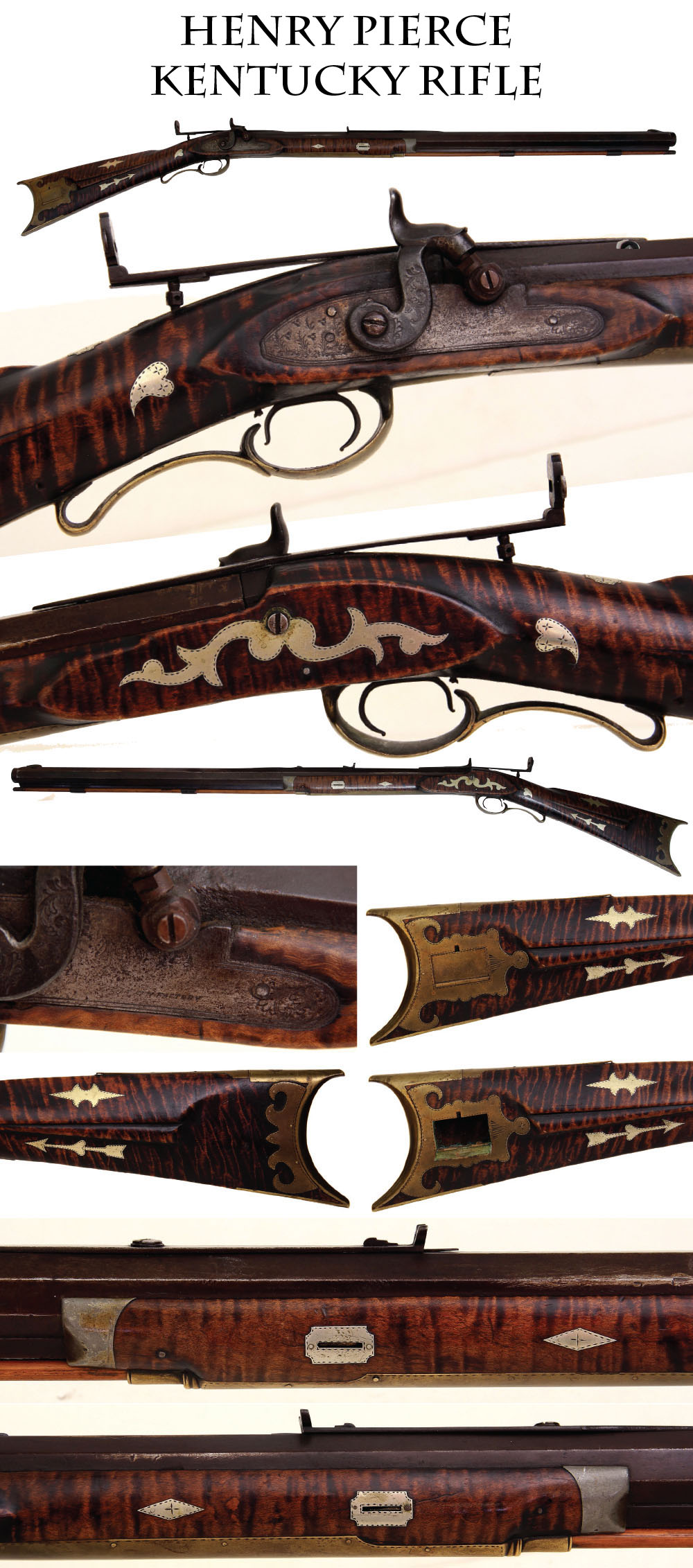
14-01-39 … Rare & High Quality Cleveland, Ohio Kentucky Rifle by Henry Pierce:
Though unsigned, this rifle is the twin brother to one signed by Henry Pierce of eastern Ohio. Of peculiar note is the ingenious set trigger design which is peculiar to this maker. The set trigger is a single piece horse shoe … push forward to set the trigger, pull back to fire. Roughly 36 caliber, 30 inch octagon barrel. Overall length 46 inches. Fine tiger stripe maple stock. Fourteen German silver inlays and it has a wonderful and attractive long brass inlay which serves as a protective plate under the forearm, so the gun can be rested on a log without fear of damaging the stock. Has a long ramp rear sight with folding peep aperture at the extreme rear. Cool inset patch box incorporated into an elaborate brass inlay near the butt plate. Small catch missing from patch box. One of the more appealing Ohio rifles one can find … and quite a scarce maker to boot. Pierce (1811-1882) was born in Lucerne County, Pennsylvania and spent most of his working life in Liverpool, Medina County, and Grafton, Lorain County, Ohio. He appears in the 1850 Census as a gunsmith and in the 1860 Census as a “Master Mechanic”. The 1850 Manufacturer’s Census lists only one employee and, that year, shows he produced but twenty guns. See Hutslar, Ohio Gunsmiths and Allied Tradesmen, Volume III, pp. 141, 144, and 184. A great Ohio rifle and a great Ohio scarcity
… $1,950.00
Click Here to E-mail Us!
Call us @ 419-842-1863

14-01-40 … Civilian Sixth Plate Tintype
of gentleman circa 1860. Nice period hard image
… $25.00 SOLD
Click Here to E-mail Us!
Call us @ 419-842-1863

14-01-41 … 1850 Pattern Schuyler, Hartley & Graham Foot Officer’s Sword.
Very fine condition Civil War infantry officer’s sword and scabbard signed by the most famous of the New York City military goods dealers. This is the regulation pattern sword for Civil War infantry lieutenants and captains, worn not just on parade, but in the field and in battle. The scabbard on this one was made with thin leather covering a steel body. As frequently happens with such scabbards the thin outer leather disintegrates when subjected to oxidation on the inner steel. The previous owner had the leather covering professionally replaced… perfectly done. The brass mounts of the scabbard and the hilt have a beautiful gentle patina. I see a couple minor dings on the drag, otherwise about perfect. The hilt is in similar superb condition. The grip has all the sharkskin wrap and the brass binding wire. Everything is tight, and even the leather pad is in place at the shoulder of the blade under the guard. Blade is bright, slightly muted, with the etching very legible. A US amid floral motifs on one side and a spread-winged eagle on the other, perched on branches and a ribband. Some slight graying in portions of the etching, but not affecting its visibility.
Schuyler / Hartley & / Graham / New York etched low down on the blade on one side, just above the blade maker’s stamp on the ricasso: “Collins & Co. / Hartford / Conn./ 1862,” another well-known name in Civil War arms who supplied blades to SH&G for retail. This is several cuts above the usual quality and condition 1850 officer’s swords out there and would look great with a nice officer’s sash. As solid as a gold dollar. Could be used safely in living history … priced very fairly at
… $1,250.00 SOLD
Click Here to E-mail Us!
Call us @ 419-842-1863

14-01-42 … A True War Horse / Folk Art, Soldier-Decorated Burnside Carbine:
A real veteran decorated by a veteran. Fifth model Burnside carbine with very folksy and appealing carving on the outboard side of the butt stock consisting of an insignia … a cross between an ambiguous crude eight-spoke wheel insignia or perhaps a stylized 5th corps badge, or it might be a Hancock’s Veterans Insignia. Next to the mystery insignia a super patriotic panel of a US shield with stars and stripes flanked by US flags draped behind it. This shows right side up when the gun is hung on the wall barrel down. A carved set of initials on the offside wrist, “IN” or “NI” might be a clue to the soldier’s identity, but I also make out a more worn “B.B.B.” crosswise near the buttplate, and a thin “H A” elsewhere. Gun has serial number 5924 on the frame and 6509 on the breech block. The barrel is nice with a smooth deep purple-plum color as is the band. The receiver is more mottled with some bright spots amid smokey gray and purple from the case color. The breechblock shows some case color when lowered . Wood is a warm brown without finish and shows dings from being issued and carried in the field, but still shows a very visible cartouche on the wrist. Swivel, sling bar and ring present, both sights in place. Needs a rear lock plate screw, otherwise good. Breechblock number does not match, but has been with the gun since it’s period of use. Obviously a gun valued by a trooper and kept as a memento of his service in the cavalry. Shows lots of war date use, but no abuse … Interesting old war horse with the folk art carving
… $1,395.00
Click Here to E-mail Us!
Call us @ 419-842-1863

14-01-43 … Scarce Large Bore Ballard Carbine in the rare .56-.56 caliber
supplied by Merwin and Bray to Kentucky in 1864. The Ballard story is a complicated one. Anyone wishing to get the basic history should consult Flayderman’s Guide as a starting point. Five different companies produced the guns at different times and in different calibers. Merwin and Bray, New York firearms dealers, were awarded a US contract for a thousand large bore Ballard carbines and rifles, and sub-contracted the work to the firm of Dwight, Chapin and Co. That firm eventually went belly up and Merwin and Bray bought their completed guns and unassembled parts, and contracted then with the firm of Ball and Williams to complete the work. Guns by Merwin and Bray can be found with both Dwight, Chapin and with Ball and Williams markings. The exception is the group of 1,000 carbines in .56-.56 caliber (actually more like .52, but that is another story) that were marked only with Ballard Patent and Merwin and Bray Agents markings. This entire group was purchased by the state of Kentucky in April, 1864. Our gun is a really nice example of that scarce contract. Clear “Ballard’s Patent / Nov. 5, 1861” markings on right of receiver and “Merwin & Bray/ Agt’s N.Y.” over serial number “483” on the left, very legible, just a little light in the center of the stamp. Sights firmly in place, including the 250 and 500 yard graduated rear leaf sight. Both swivels in place- like many early war carbines this was intended to be carried on a more conventional style rifle sling rather than the wide and cumbersome brass mounted carbine sling. Very nice wood with good, even dark tone, and sharp edges. I see just one or two light rub marks. Nice smooth metal overall, mixed plum with darker smoky blue and a little gray here and there. A few expected handling dings on the receiver. Overall a very attractive carbine with homogenous patina on all the metal. Mechanically perfect. 100% original, 100% complete. A key weapon in a carbine collection and a very scarce one in this caliber and condition. Also a real nice piece of Kentucky history. Rates NRA Very Good +++ to near fine condition
… $2,450.00
Click Here to E-mail Us!
Call us @ 419-842-1863
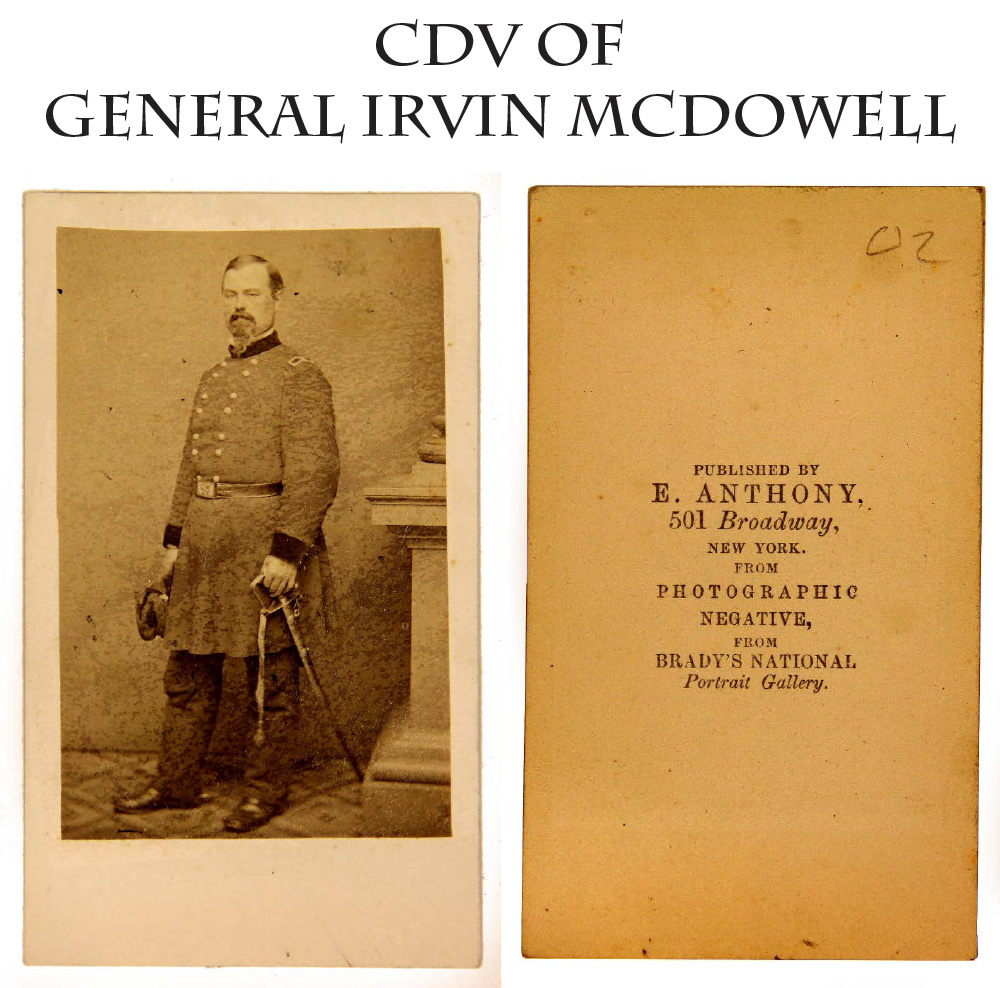
14-01-44 … CDV From-Life – Brigadier General Irvin McDowell …
Good full-standing view of the famous, but ill-starred, general. E. Anthony New York backmark made from the Matthew Brady negative that was part of his National Portrait Gallery. McDowell wears a brigadier generals frock coat and straps, a rank he gained in May, 1861, holding his trademark cap down at his side and holding the hilt of a saber hanging from his belt. (The sword looks Austrian, and Austrian goods were all the craze at the time.) He was West Point Class of 1838 and served on Wools staff in the Mexican War. Forever tied to the defeat at First Bull Run, he is perhaps more famous for the extra tall forage cap he wore which collectors still refer to as a McDowell Pattern Cap. Later he was in command of the Department of the Pacific. He made major general in the regular army in 1872, and retired in 1882. Ironically, he taught tactics at West Point in the early 1840s, likely to some future high-ranking Confederate officers
… $79.00
Click Here to E-mail Us!
Call us @ 419-842-1863

14-01-45 … Scarce US Model 1835/40 Conversion Musket. D. Nippes/ US 1843.
Nippes made 5600 contract muskets in the 1835/40 pattern, most of which were converted to percussion. This is one of those guns. Overall condition very good to attic fine. Has two clear cartouches on the stock opposite the lock. Wood is extra fine. A tight sharp musket and one of the scarcer patterns. 100% original and complete, except for replaced rod done during the period. Mechanically perfect. Some light rust on the metal that may clean. A scarce gun at a fair price
… $995.00
Click Here to E-mail Us!
Call us @ 419-842-1863
14-01-46 … 1795 Springfield Flintlock Musket:
Copied from the 1766 model French Charleville musket, the 1795 Springfield was the very first official infantry longarm of the United States. Initially with the bayonet lug on the bottom of the barrel, this was rotated to the top of the barrel in 1797 and the look remained more or less the same to the end of the War of 1812. On this specimen the lug has been removed, it had been on the top and remnants of it are clearly present. Made too late for the Revolutionary War, these were the standard US Regular Army arms in the War of 1812. Whether defending Fort McHenry in Baltimore, or in the earthworks around New Orleans under the watchful eye of Andrew Jackson, these muskets were there. Its greatest test was with Winfield Scott at Lundy’s Lane in 1814. Thousands of US troops stood face-to-face against British regiments exchanging volley after volley of musket fire well into the night. This specimen grades about NRA good. It appears to be in original flintlock configuration. Lock is nicely marked with US over Springfield and also 1809. The date on the butt plate is 1814. Stock is full length and has a rather large repair to a crack in the wrist. This repair also incorporates a patch in the top of the wrist which I am sure hides the head of a wood screw used in the repair. Someone added a crude V notch rear sight during the guns period of use. The barrel is stamped V eagle P as well as US. Trigger guard plate has two initials, PT. Stock is incised with initials LK, presumably the owner. The ramrod is of the period but not the original rod, and it is also too short for actual use with this musket. It stands as a suitable stand-in for display purposes. Here is a darn good deal on a piece from the early days of our Republic.
… $1,250.00 SOLD
Click Here to E-mail Us!
Call us @ 419-842-1863
14-01-47 … M-1840 Heavy Cavalry Saber:
A very nice example in VG+ condition. The only “wart” is the missing throat on the scabbard. The 3-branch guard is excellent with traces of gilt mixed with age patina and grunge. The 35+ inch blade is mostly factory bright with factory cross brushing still present near the ricasso… has some age staining and surface rust that can be
easily
removed. Leather grip with twisted wire wrap is all original and near perfect. Scabbard is VG+ … overall grey steel with small areas of grunge and rust. Both US and CS troopers carried these wristbreakers early in the Civil War, making this perfect for Union or Confederate display. This is a very solid example and it truly is “a diamond in the rough”. A little cleaning and replacing of the throat will put this saber into a whole new league
… $495.00
vxcjjpqr
SOLD
Click Here to E-mail Us!
Call us @ 419-842-1863
14-01-48 … Ames Civil War NCO Sword and Scabbard:
Regulation m1840 US Non Commissioned Officers sword made and marked by Ames Mfg. Co. and dated 186? with full inspectors marks. (The last digit of the date appears to have not been struck, or was struck so light as to not be legible.) Sword is VG to Fine condition. Blade excellent. The scabbard is the original and proper brass mounted leather type. When we found this it had a break in the leather scabbard and some loss above the drag. The original drag was still present. I had helper Tom repair this using a small section of original leather NCO sheath that I had saved from another example. He did a great repair. Beautiful patina on all the brass.
This is the sword carried by corporals and sergeants in the Union Infantry
… $435.00
Click Here to E-mail Us!
Call us @ 419-842-1863
14-01-49 … Regulation Civil War 1858 Pattern Smooth Sided Canteen with Original Cover and Strap.
Most that I find lack the cover or the strap, or have ones that look suspiciously new! Here is an original and completely genuine untouched Civil War soldiers example. Gray wool body cover, characteristic loose weave, some stains here and there, one slight wear spot, but no tears or mothing. Original linen strap in place, full length, just a little abrasion at the tops of the brackets where the roughness of the metal wears the cloth or transfers rust. Lightly scratched in initials on each bracket, LH, undoubtedly the soldier who carried it. Lacks the cork stopper, which on this pattern would be secured with a doubled string cord. Originals show up from time to time and it should not be difficult to find one if you want to. I like it as is, just the way LH brought it home
… $345.00 SOLD
Click Here to E-mail Us!
Call us @ 419-842-1863
14-01-50 … GAR Photo Identified 6th US Cavalry Trooper:
The Sixth US Cavalry was an interesting unit and there is a regimental history just recently released. Recruited in May, 1861, in Pennsylvania and Ohio, the regiment was a new addition to the US army and was originally designated the Third US Cavalry. When all mounted units were redesignated cavalry in August the Third changed its numerical designation to the Sixth. It was mounted and equipped in Maryland in September, though only two companies were issued carbines until early 1862, the regiment being considered light cavalry until then, most companies armed only with pistols and sabers. It then took the field and saw its first fighting with McClellan during the Peninsular Campaign that Spring.
Here is a photo of one of their veterans, roughly a 3 3/4″ x 4 7/8″ oval, wearing a GAR coat by the look of it, with a GAR lapel stud as well, taken about 1890. Obviously removed from a frame at some point. Irregularly trimmed along edge and some edge chipping, glue spots on reverse, but not affecting image itself and would look great matted again. Identified along lower edge in period ink: H.E. Vick B U.S. Cav. and on reverse No. 3 / Holend Vick/ B 6 US Cav. in ink and pencil. Holland E. Vick enlisted as a private in Co. B of the 6th US Cavalry on August 5, 1861. He was discharged for disability Oct. 18, 1862, at Fortress Monroe, but this would have given him service during the Peninsular Campaign and through Antietam. A cursory online search shows a Holland Vick born in Ohio in 1834, and this may be our man, though the regiment also supposedly had a large number of recent Irish immigrants in it. It had a good wartime record though, and many of its officers were transfers from other regular army units when it was first organized
… $69.00
Click Here to E-mail Us!
Call us @ 419-842-1863
14-01-51 … World War II Fighting Knife:
This was ordered by a lady a few weeks ago but she never sent her check. World War II field or theatre-made fighting and utility knives are a specific area of collecting. Soldiers in all combat areas took the opportunity to personalize these sidearms when they could. I don’t claim any special expertise in the field, but I could not pass this one up when it was offered to me. This is a sturdily made and hefty fighting knife marked with a small anchor in circle ink stamp on one side of its wood slab grips. Measuring 11 inches overall with a substantial blade 6.25” in length with a false edge coming back from the point. Grips are square in cross section with beveled edges and are secured by three rivets. Zinc? end cap and crossguard with short branches. Someone might recognize the maker mark. I don’t, but whoever the maker was, he knew his business. … A neat ww2 knife
… $125.00 SOLD
Click Here to E-mail Us!
Call us @ 419-842-1863
14-01-52UP … Near Mint Harness Leather NCO or Musician’s Sword Sling and 3-Prong Eagle:
A near mint example just like the old days. This is the “over the shoulder” rig. Fine solid brown harness leather sling. Beautiful circular brass eagle plate with three prong back
… $795.00
———-
14-01-53UP … Rare M1839 Small US Buckle on narrow white buff leather belt complete with standing leather loop adjuster.
Beautiful small US buckle with ultra attractive light age patina and single hook & prong device on the reverse. These little gems are extremely scarce and were worn from the 1830s through the 1860s
… $695.00 SOLD
———-
14-01-54UP … Scarce Square Flap Civil War Cap Box
… The earlier (and scarcer) square flap model cap box with most of the original sheep’s wool inside (no pick). This has the square shaped outer flap with separately attached (sewn) latch tab. Harder to find than the later cap boxes that incorporate the latch tab as an integral part of the piece of leather used to form the front flap. Very Good to fine condition. No damage. Great for a Confederate display as the rebs utilized this square flap design 95% of the time
… $295.00
———-
14-01-55UP … Standard Union Army Civil War Cap Box Watertown Arsenal 1864:
The standard issue cap box with a most desirable arsenal marking and date on the inner flap. This is the standard cap box that incorporates the latch tab as an integral part of the piece of leather used to form the front flap. Very Good to fine condition. No damage. Slight flaking on the two belt loops of no consequence. Dated cap boxes are darn rare
… $295.00
———-
14-01-56UP … Extra Fine Standard Union Army Civil War Cap Box:
Top drawer example of the standard issue cap box in truly super condition This is the standard cap box that incorporates the latch tab as an integral part of the piece of leather used to form the front flap. Very Fine condition. No damage. Leather is deep brown. No markings. No wool nor pick
… $265.00
———-
14-01-57UP … Extra Fine Standard Union Army Civil War Cap Box with Wool And Pick:
Overall VG to fine condition just showing light handling age. This is the standard cap box that incorporates the latch tab as an integral part of the piece of leather used to form the front flap. Very Fine condition. No damage. Leather is deep brown. No markings. Has the elusivive sheep’s wool and pick still present
… $295.00 SOLD
———-
14-01-58UP … CW REVOLVER CARTRIDGE BOX:
Standard issue Union Army cavalryman’s cartridge box for use with the troopers Colt or Remington (or other) revolver. This is the standard size once thought to be 36 caliber but since proved to simply be standard for 36 or 44. Very good solid condition showing only the gentlest handling wear. Very solid condition … (These were $5 each in 1972!!!) Most dealers are pricing these things at 250 fairly priced
… $195.00
———-
14-01-59UP … ANOTHER PISTOL BOX:
This one in really fine condition … Really superb condition, much nicer than most currently available. Nearly new
… $235.00
SOLD
———-
14-01-60UP … Large Size Pistol Cartridge Box:
Same exact design as the above cartridge boxes but 15% larger in size and about 20 times scarcer. Fine condition just showing honest handling age. Once thought to be for 44 caliber guns, now known to simply be a larger variant
… $265.00
———-
Click Here to E-mail Us!
Call us @ 419-842-1863
———-
14-01-61UP … BULLSEYE CANTEEN w/ COVER …
The highly sought 9 ring example. All 3 brackets firmly in place, and retains the original issue tan brown wool cover. Pewter spout firmly in place. Overall excellent
… $265.00 SOLD
———-
14-01-62UP … Pair of INDIAN WAR CANTEENs.
Both are dented and rusty, both have covers, one has the metal parts of a stopper (cork gone) both have the triangular strap brackets. Price for the pair
… $59.00
———-
14-01-63UP … CW OFFICER’S EAGLE BUCKLE / SWORD BELT PLATE:
A fine, attractive specimen of the rectangular officer’s ‘eagle buckle’ with fine detail to the face, and solid wreath integrally cast into the plate. Shows light age, pretty patina, and has mid war medium width tongue
… $295.00
———-
14-01-64UP … US OVAL BELT BUCKLE:
The standard Union issue US oval buckle with arrow hook back. Excellent condition just showing honest age and patina
… $245.00
———-
14-01-65UP … STUD BACK US OVAL BELT BUCKLE:
Early war style US oval with lead filled back and two oval “puppy paw” studs and prong as used early in the war. Very fine showing just honest age, getting very hard to find
… $345.00 SOLD
———-
14-01-66UP … CIRCULAR EAGLE SHOULDER BELT “BREASTPLATE” …
Non dug and attractive circular eagle plate for use on the cartridge box shoulder strap. Really nice and getting scarce
… $225.00 SOLD
———-
14-01-67UP … FINE 3-PRONG EAGLE BREASTPLATE:
A scarce & desirable plate being the circular eagle plate w/ lead filled back w/ 3 prongs for use with the NCO and musician’s shoulder support belt for their swords. Fine detail and great light age patina. These are nearly IMPOSSIBLE to find any more
… $395.00
———-
14-01-68UP … US CARTRIDGE BOX PLATE:
Identical to the US oval buckles, but having two iron wire loops on the back for securing to the flap of the cartridge box. Fine non-dug condition
… $225.00
———-
14-01-69UP … MUSKET WORM OR BALL PULLER:
This one is cork screw style threaded to fit on ram rod. Looks like standard CW style puller. About 1″ o/a length with short shank threaded to attach to rod
… $30.00
———-
14-01-70UP … MUSKET WORM OR BALL PULLER:
This one is the threaded screw variety where the puller looks like a wood screw sticking out of a heavy steel shank. About 1″ overall length
… $35.00
———-
Click Here to E-mail Us!
Call us @ 419-842-1863
———-
14-01-71UP … CUFF SIZE INFANTRY OFFICER’S BUTTON:
A very fine example of the eagle “I” button, with traces of gilt and lovely patina. Excellent CW button
… $25.00
———-
14-01-72UP … CIVIL WAR PATRIOTIC ENVELOPES:
A lot of 5 wonderful color patriotic envelopes from the Civil War (unused). Perfect to display with soldier effects or to collect by themselves. Have nice patriotic or anti-southern sentiments on the fronts. I used to have piles of these… Totally ran out two years ago and then found ONE more major collection on the internet a few weeks ago. These are GREAT Lot of 5 for
… $69.00
———-
14-01-73UP … CIVIL WAR NEWSPAPERS:
I have a few great papers I put back years ago. Some with great battle content and some with maps. Mostly New York papers.
… $20 to $60 each … call
———-
14-01-74UP … CIVIL WAR FIFE:
Excellent example of the classic CW fife … This one constructed of rosewood wood with pretty silver end ferrules
… $139
———-
14-01-75UP … LARGE 1860 ERA WALLET W/ EMBOSSED DECORATIONS:
Absolutely classic CW wallet guaranteed to date from 1840s to 1860s period. Embossed with various motifs. Really appealing
… $75.00
———-
14-01-76UP … BRASS FRAME BEN FRANKLIN EYEGLASSES:
Oval lenses. Super patina, well made with extendible ear pieces. Excellent condition (just the glasses no case)
… $59.00
———-
14-01-77UP … CIVIL WAR ARTILLERY HAT CORD:
Perfect surplus example of the red worsted wool artillery hat cord for use on the Hardee hat. I was recently able to purchase a couple dozen from an “old timer” who had some from the old Bannerman days. While the supply lasts
… $45.00
———-
14-01-78UP … CIVIL WAR INFANTRY HAT CORDS:
Solid condition with good color
… $100.00
———-
14-01-79UP … CIVIL WAR CAVALRY HAT CORDS:
As above but yellow color. Getting hard to find
… $175.00
———-
14-01-80UP … INDIAN WAR CAVALRY HAT INSIGNIA:
Mint surplus M-1872 cavalry crossed saber hat insignia with all the attaching wires
… each $30.00
———-
14-01-81UP … REGULATION PAIR OF ENLISTED SHOULDER SCALES:
Excellent set of privates scales or epaulets, as worn on the shoulders of the enlistedmens coats to ward off saber blows (didn’t quite work that way in real life though) Fine with delicate patina
… $295.00
———-
14-01-82UP … 1872 INFANTRY INSIGNIA STAMPED BRASS:
Looks like I have four of these French Horn stamped brass insignia. I believe they are the US 1872 pattern. Will sell for
$20 each or $70 for the lot.
drwr5
———-
14-01-83UP … MUSICIAN’S LYRE INSIGNIA:
Nice stamped brass insignia with two attaching prongs on the reverse. Nice deep patina. Measures roughly 1.25 inches tall
… $40.00
———-
14-01-84UP … DELUXE CIVIL WAR FIFE:
Standard pattern but wonderfully decorated with eight brass rings around the rosewood body. Perhaps these helped the fifer keep control of his finger placement. Really a top end fife
… $225.00 SOLD
Click Here to E-mail Us!
Call us @ 419-842-1863
Layaways are Welcome
Need to split your order into multiple payments? No problem! A simple 20% earnest money deposit will hold your item for you.-acf
You can then pay it off in easy installments that fit your budget.
Read Terms Here
Items to Sell? Contact Us
I am always interested in buying ANYTHING from the American Civil War… Guns, Swords, Civil War Muskets, Knives, Uniforms, Flags, Medals, Badges, Diaries, Letters, Autographs, Buttons, photographs, tintypes, daguerreotypes, Insignia, Camp Items, Battlefield Relics, canteens, Drums, Etc… Call 419-842-1863 and ask for Dave Taylor.

